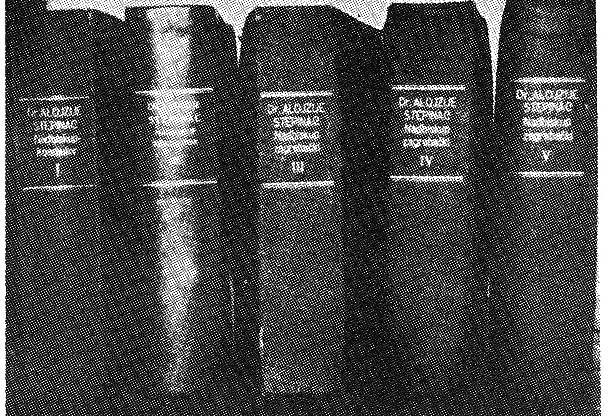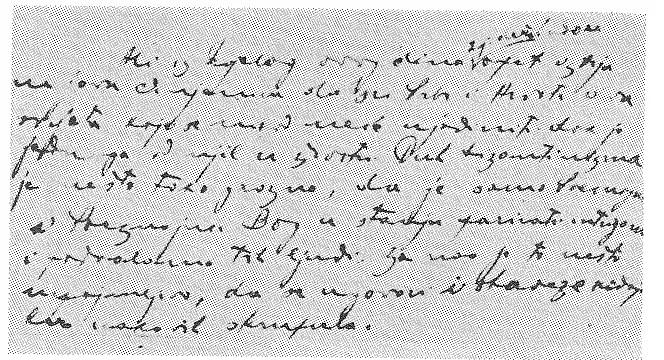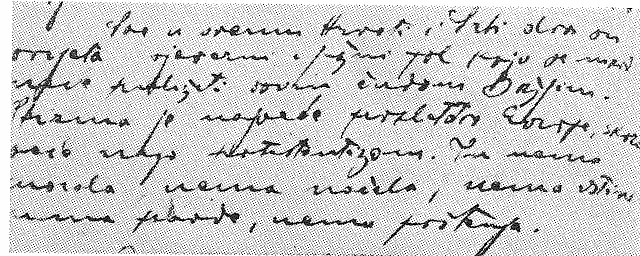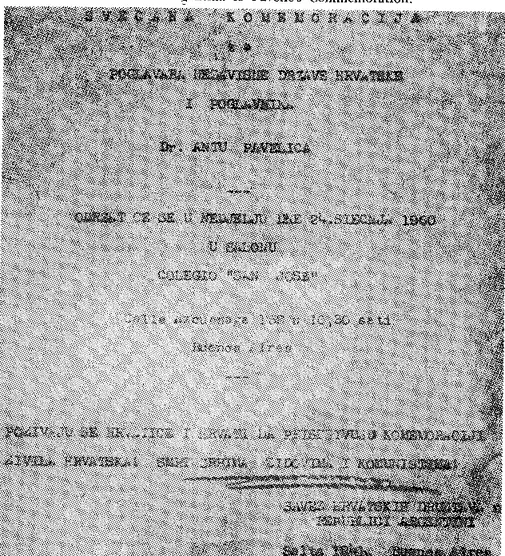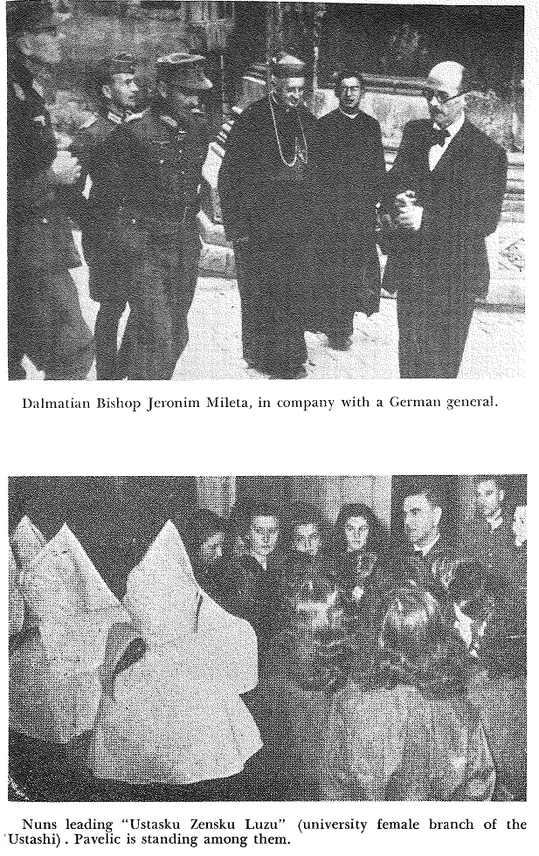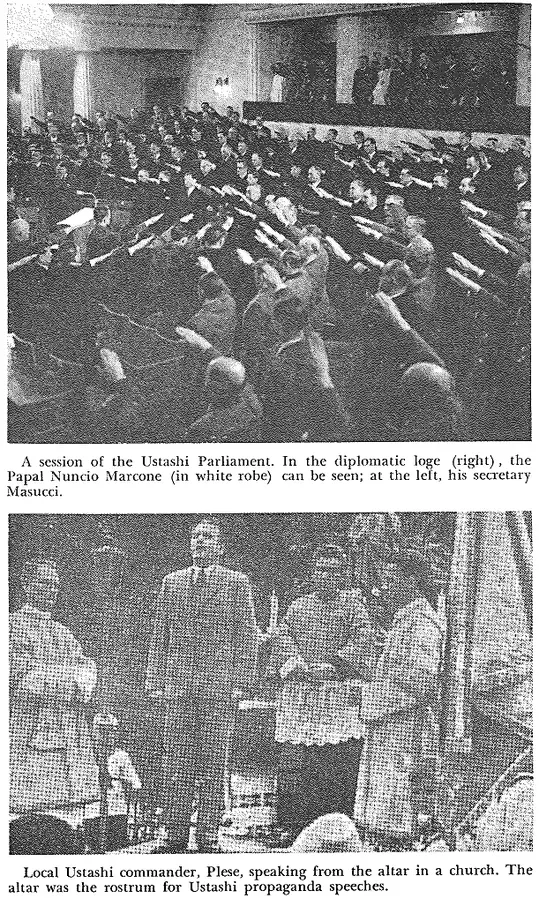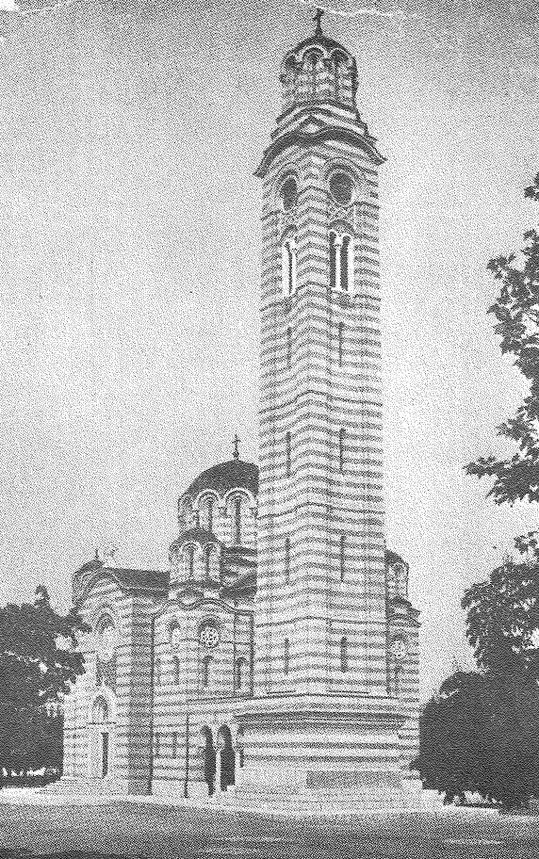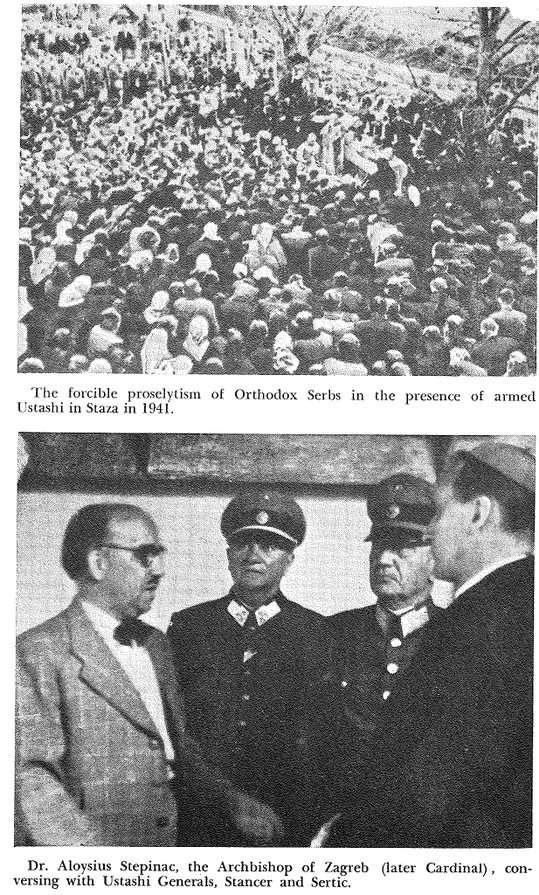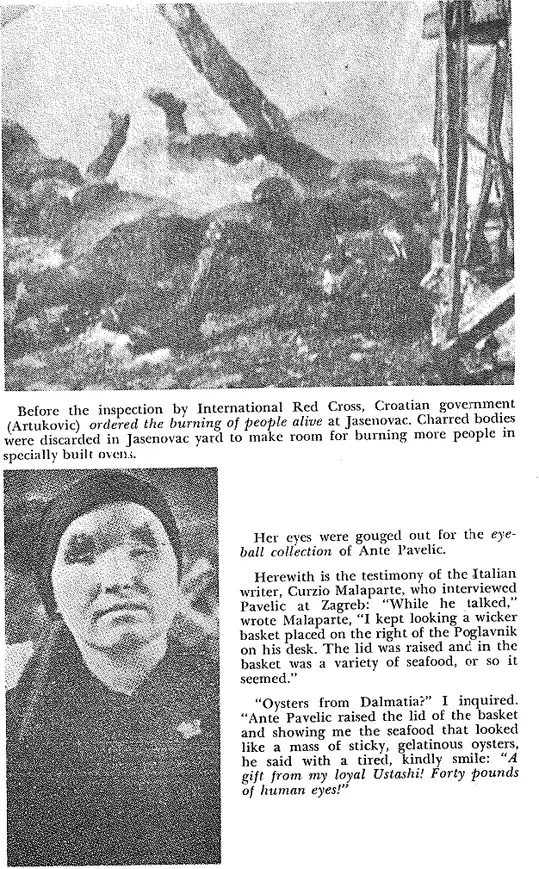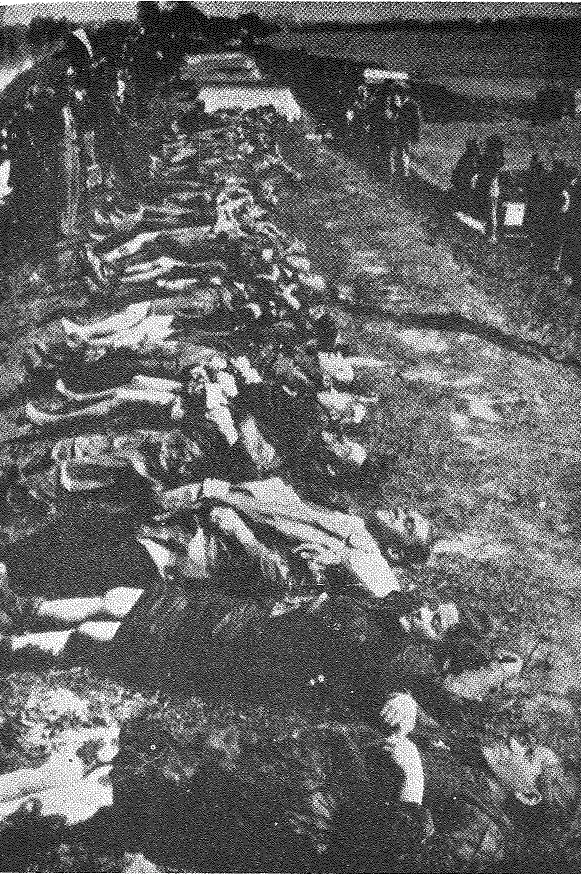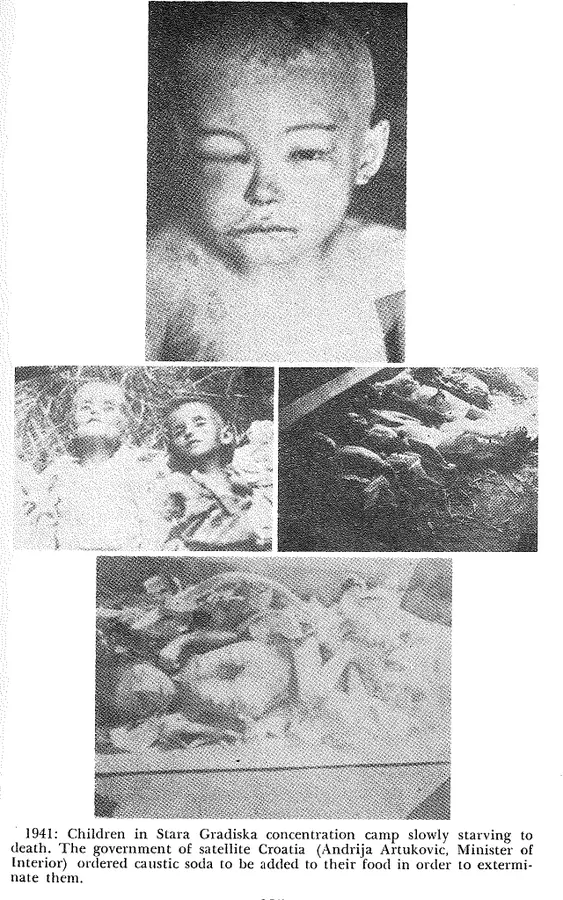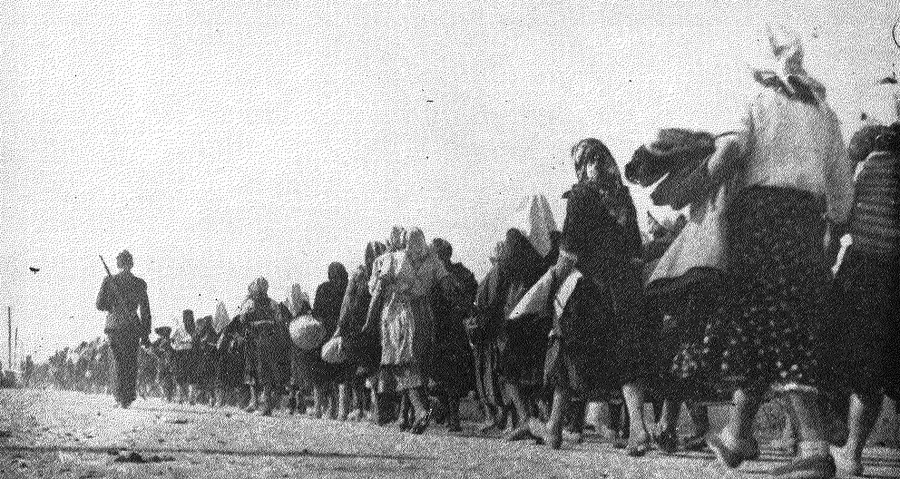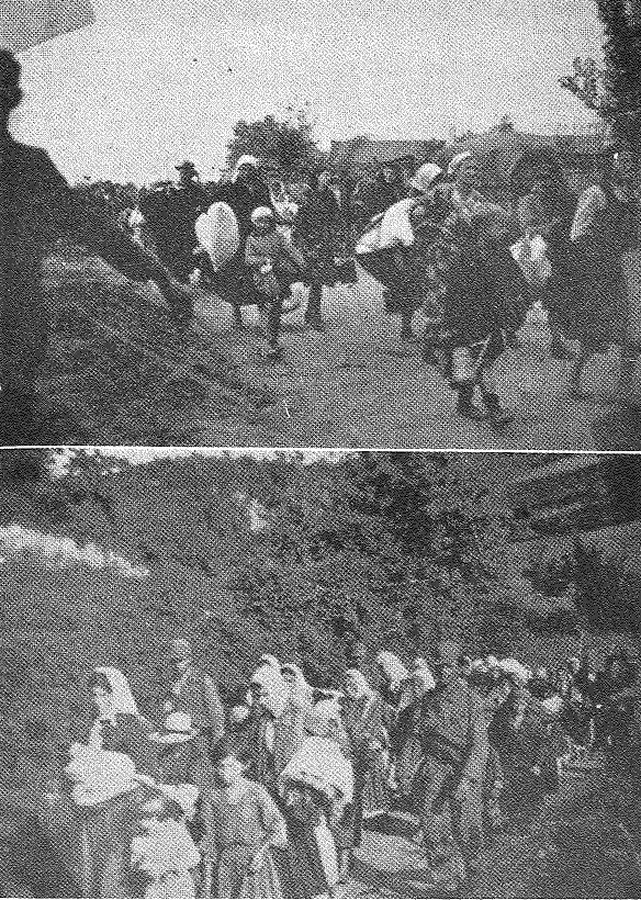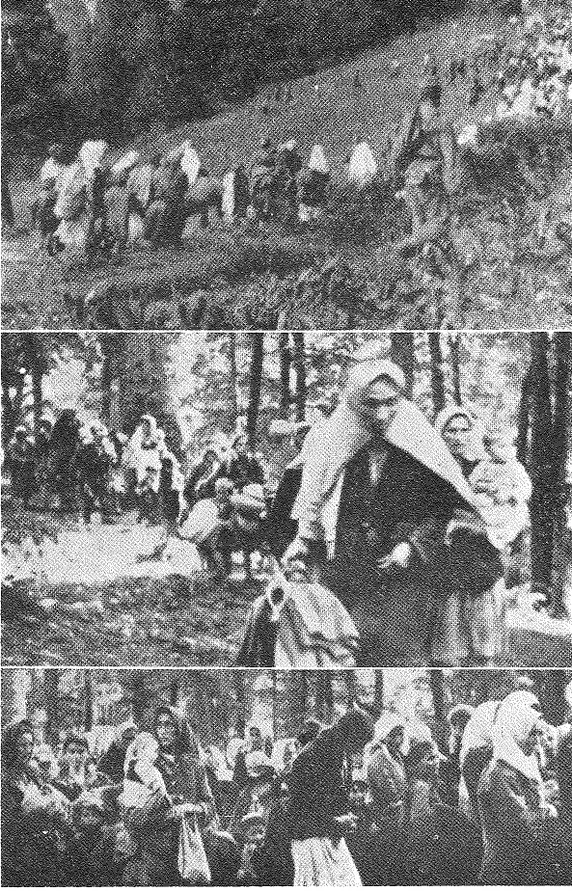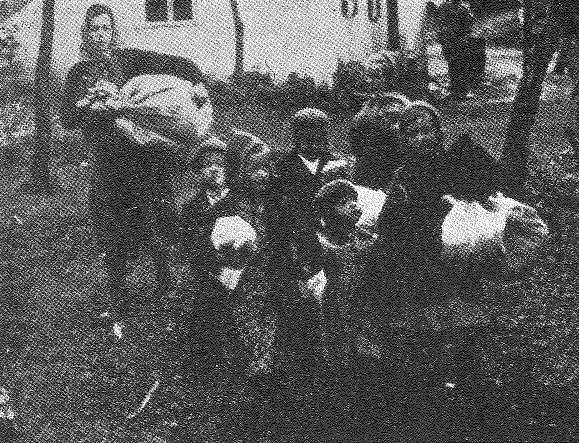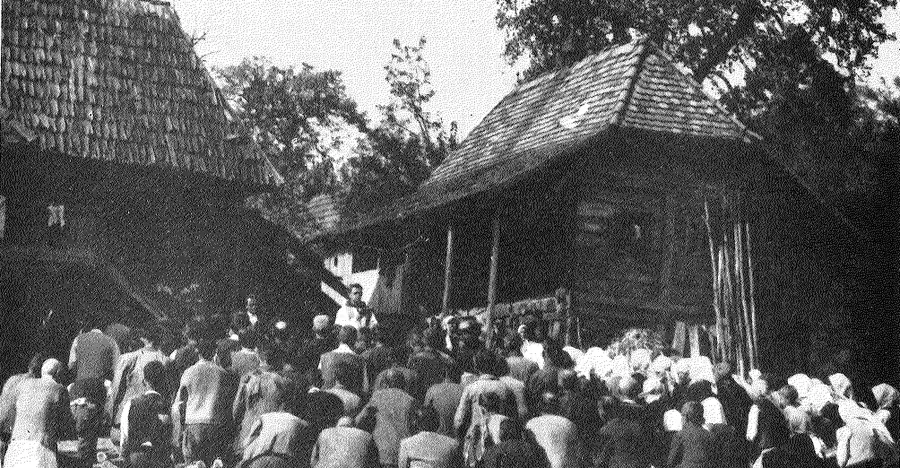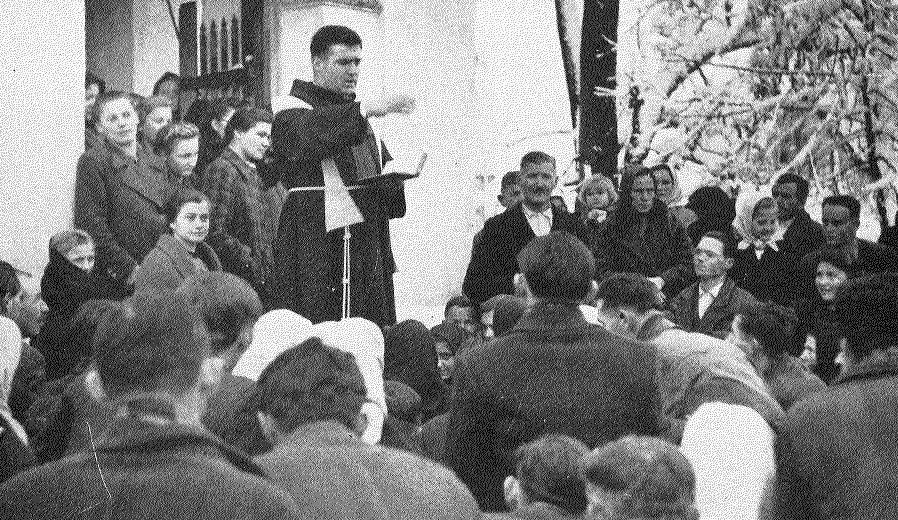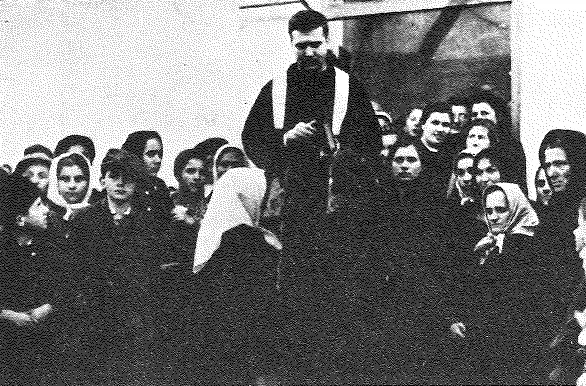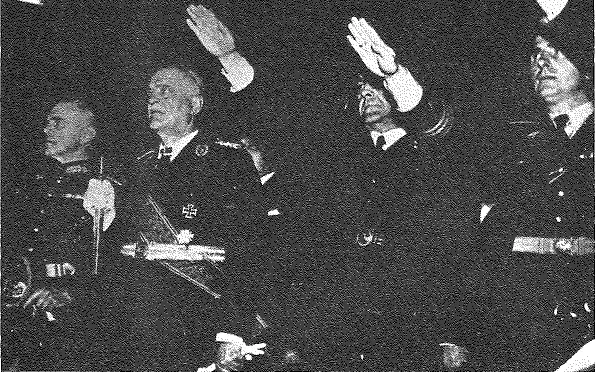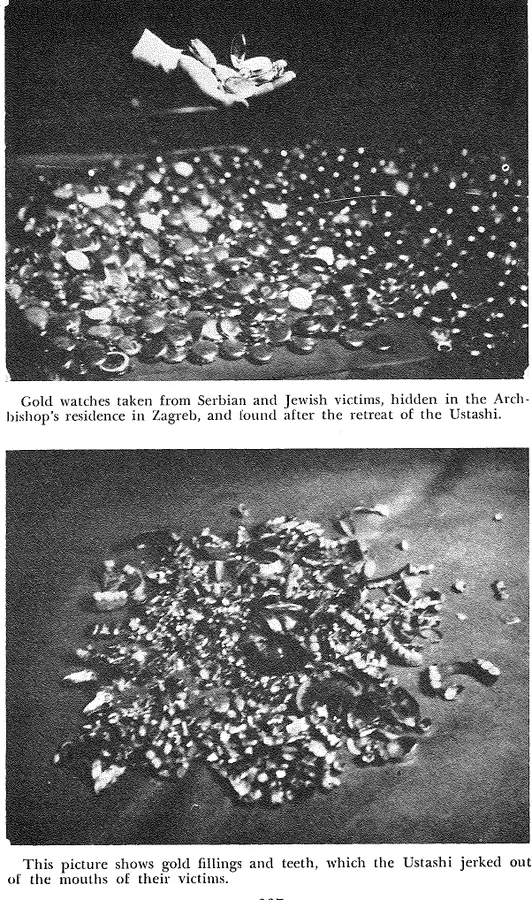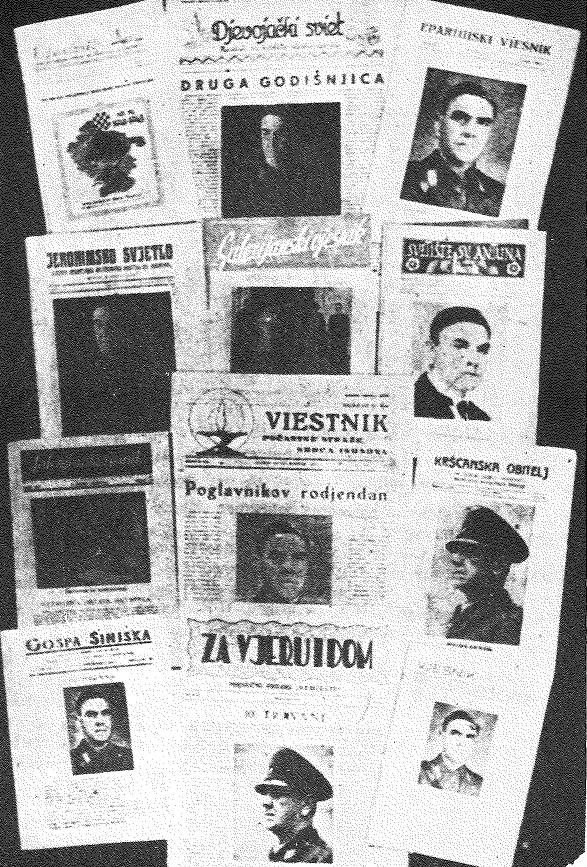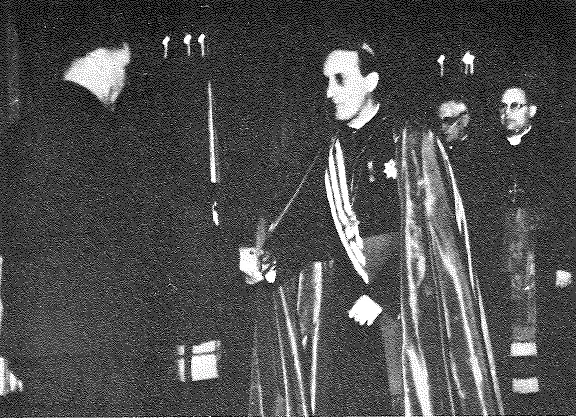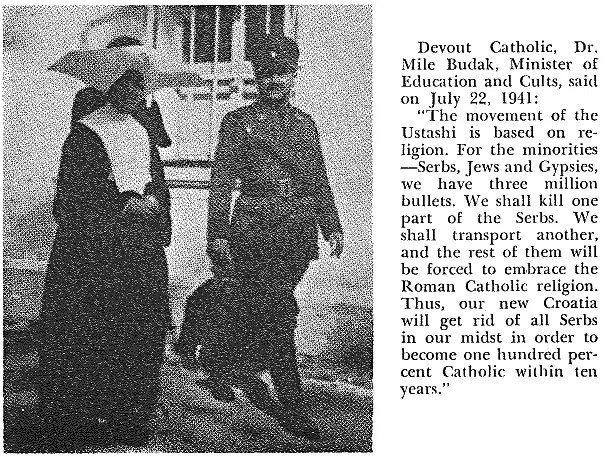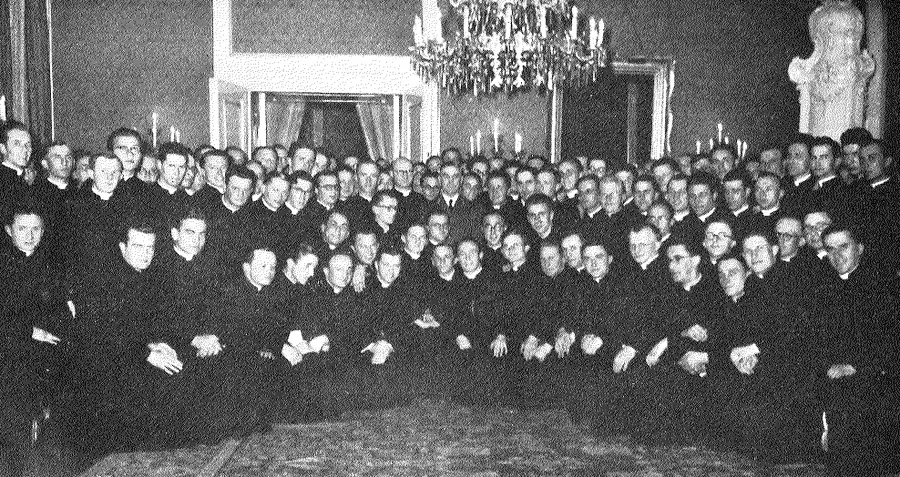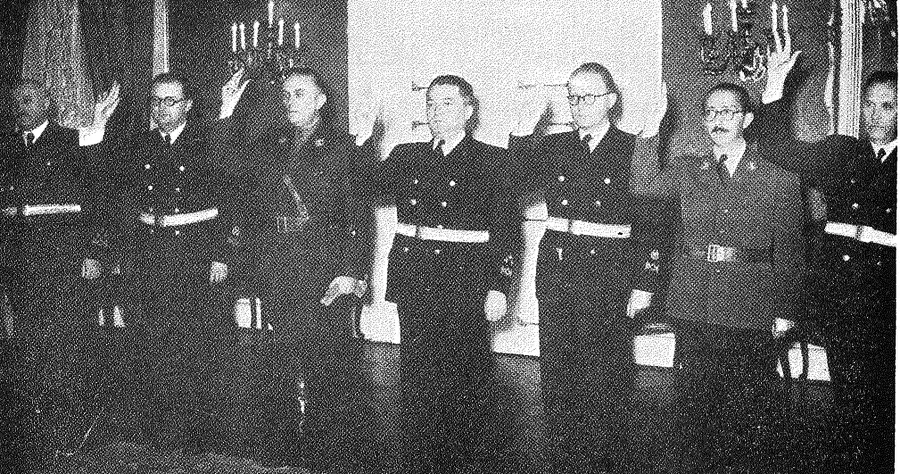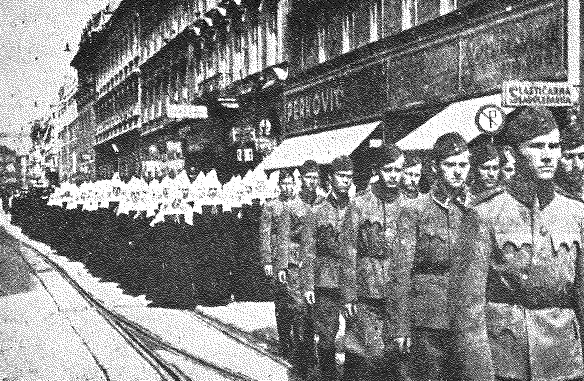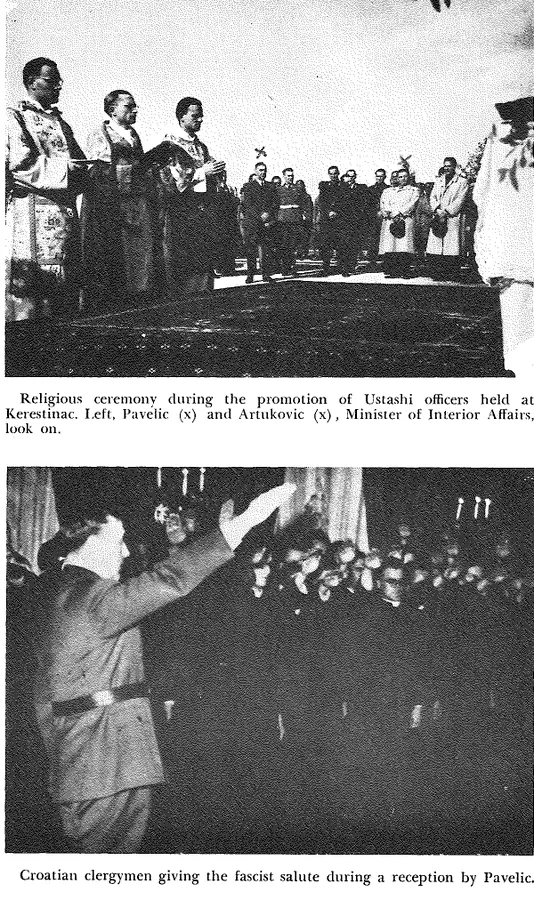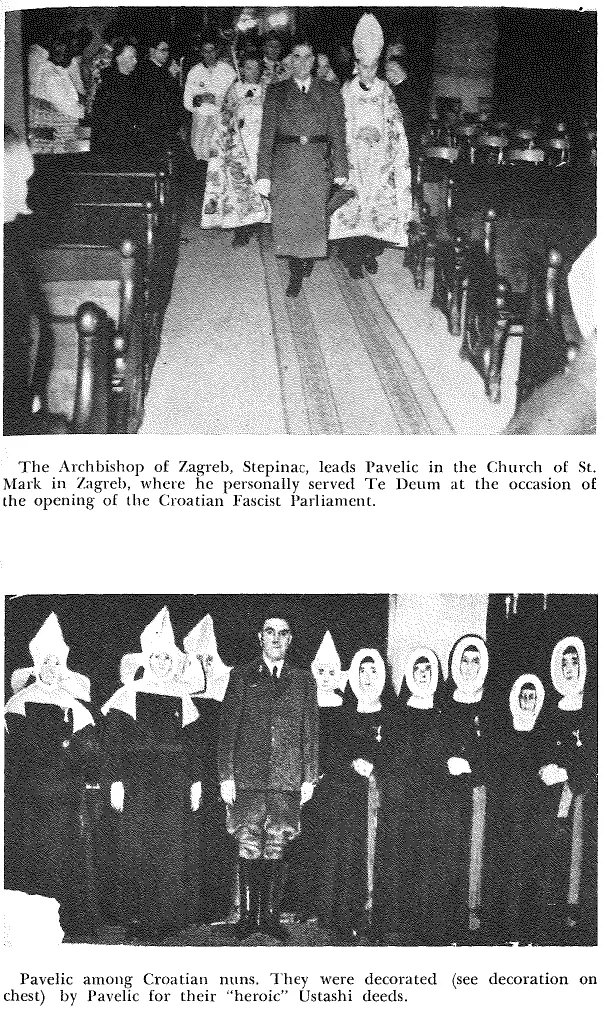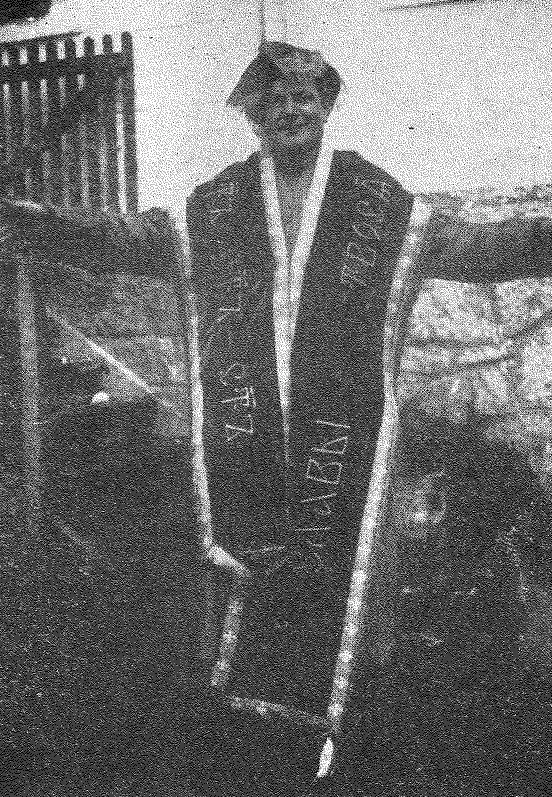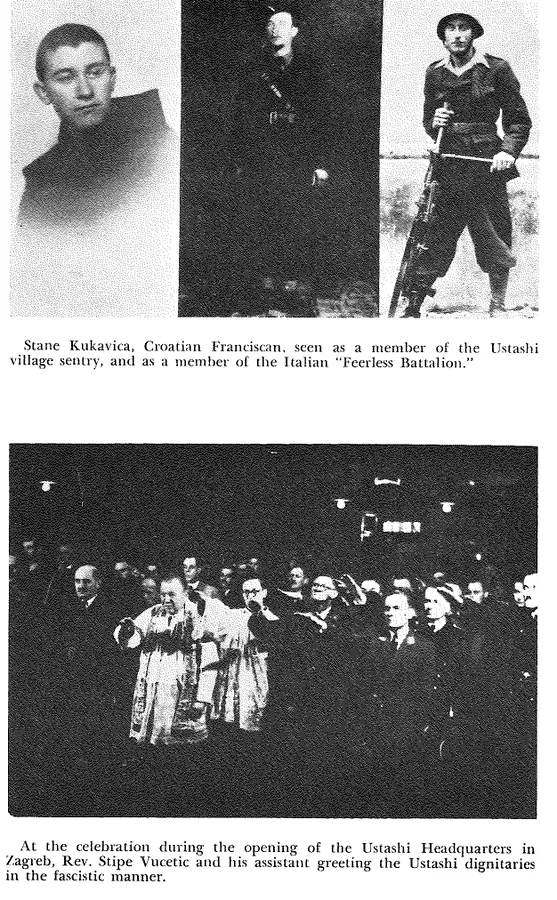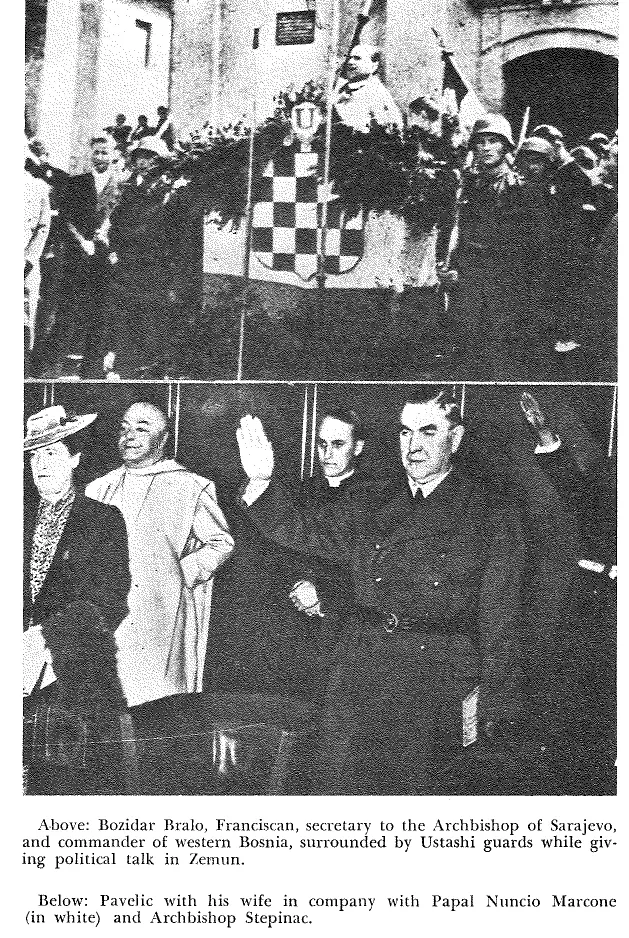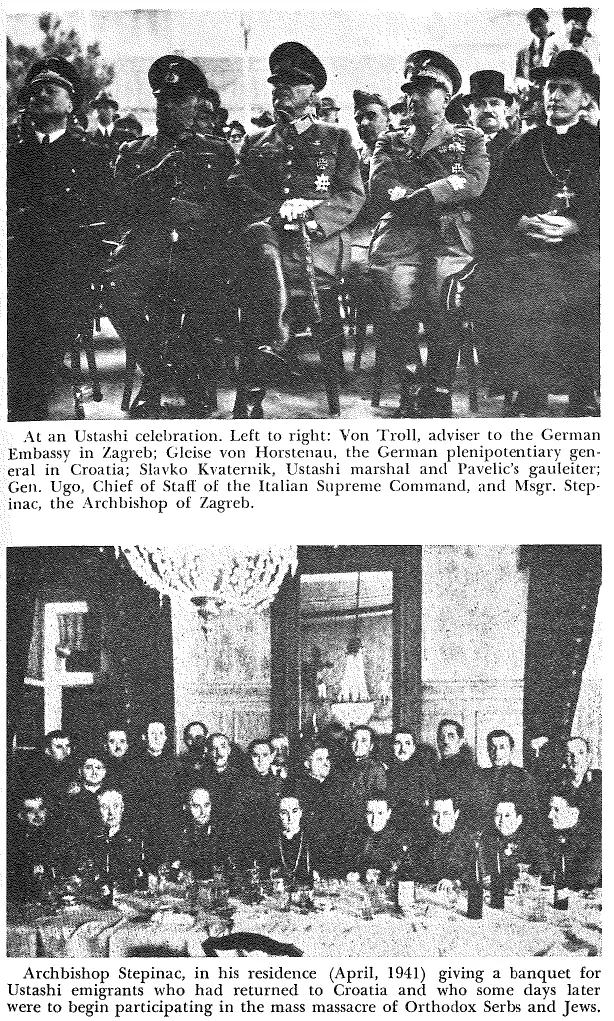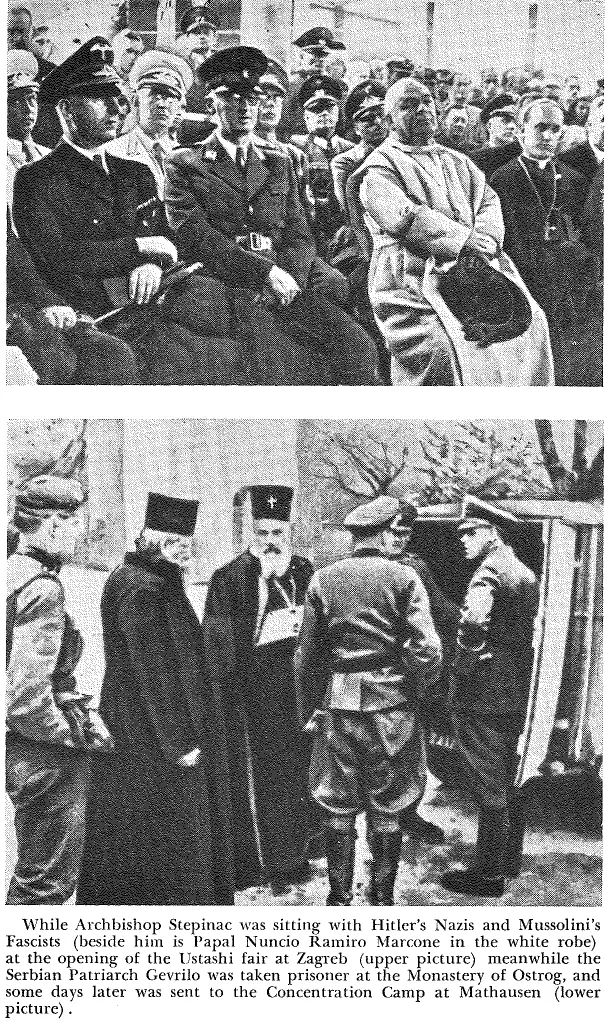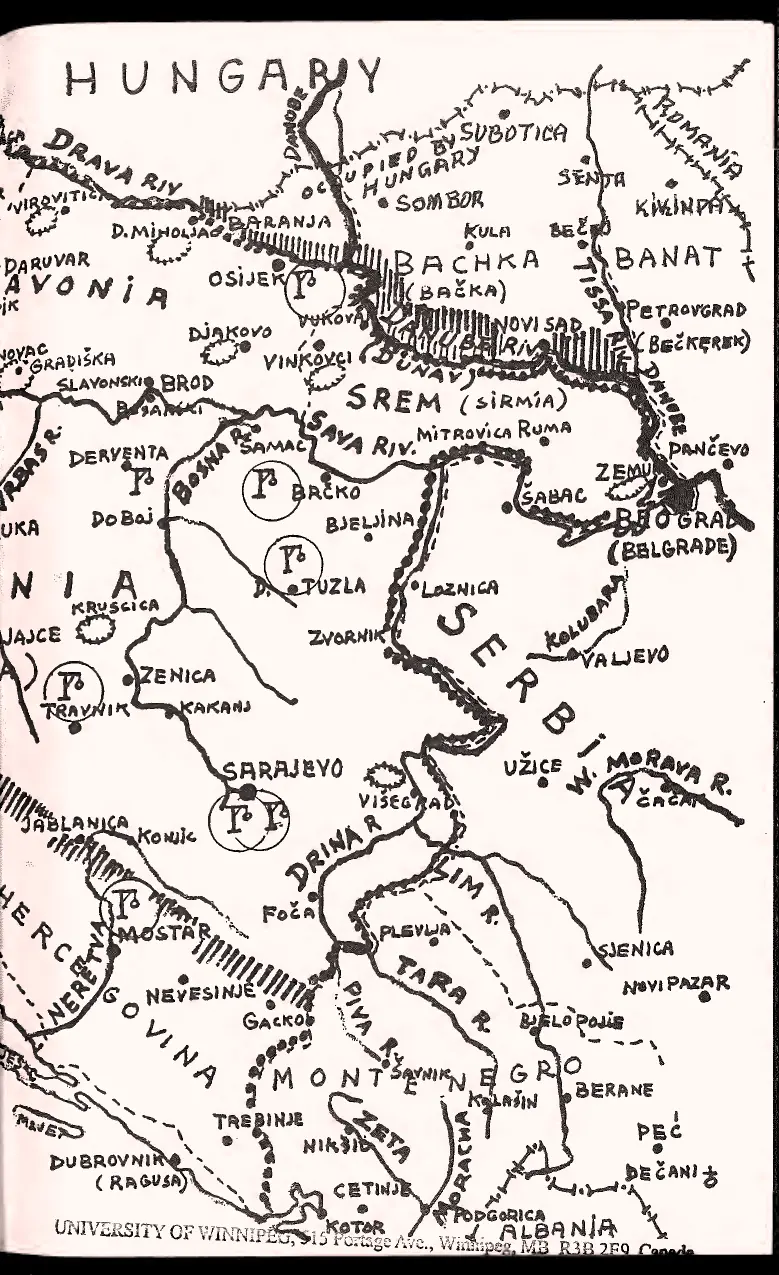Continued from Chapter IV. The Massacres Begin.
AT THE END of June, 1941, only two and a half months after the proclamation of the “independent” state, all the elements necessary for the great crusade of “croatization” were centralized and controlled by the Ustashi government. For this purpose it had mobilized a small army, formed special divisions, set up a constabulary, diverse police services, and special courts, while being guaranteed the passive benevolence of the Italian and German representatives. The Croatian Peasant party maintained an attitude half way between tacit complicity and effective participation. Finally, the voices of the highest representatives of the Catholic Church throughout the country, by their exhortations from the pulpit and the dithyrambic (wild and boisterous) articles in the newspapers and periodicals, covered, in advance, the acts of the Ustashi government.
On June 26th, Ante Pavelic gave an audience to the Catholic episcopacy. Up to this date, he had already on his account the massacre of 180,000 Serbs and Jews, as well as the martyrdom of three bishops, and more than 100 Serbian Orthodox priests and members of religious orders. Such a list of victims “on his slate,” in such a short time, was an auspicious beginning, and gave a true significance to the sermon delivered by His Grace, Stepinac, who said that “as legitimate representatives of the Church of God in the Independent State of Croatia, of which you are the Head, we utter our deference with our whole hearts, and promise our sincere and loyal collaboration for the brightest of futures for our fatherland.” Katolicki List, n°26, 1941, and Hrvatski Narod, June 80, 1941.
The involvement was, therefore, made as clear as it possibly could be. Two days later, on June 28th, by order of Eugen Kvaternik-Dido, the magnificent Serbian Orthodox cathedral at Bihac was blown up with dynamite. So that the disaster would be more complete, that same day he had 2,000 Serbs and Jews massacred in the town and its surroundings.
The day following, June 29th, the organizations of the Catholic Action, with the “Great Brotherhood of Crusaders,” and the “Great Sisterhood of Crusaders” in the lead, took their turn to render homage to Pavelic, the tireless defender of religious faith. See Nedelja, June 29, 1941.
And again on the next day, June 30th, a new decree (No. 48468/41) was issued with detailed precision of the terms of the decree of May 3rd, referring to the conversion from one religion to another, which concerned the transfer of the believers of oriental rites (This was the “official” Croatian term designating the Serbian Orthodox.) to Catholicism. Foreseeing that many among these, being forced to abjure, would prefer embracing the Greek-Catholic religion rather than the Roman Catholic, this eventually was made impossible by the following conditions, only the more important of which are cited here:
1. The government stipulates that all persons who follow the Greek oriental rites shall not be allowed to be converted to the Greek Catholic religion, except in parishes where the practice of the Greek-Catholic ritual already exists and is observed by believers of the Greek-oriental rites.
2. The Eastern Orthodox who register in the offices of Roman Catholic parishes for conversion must show recommendations stamped by the Police or the Town Hall, testifying to their honesty. These recommendations will be delivered after the approval of the Ustashi organizations. The Town Halls and police authorities are ordered to inform the Ministry of Cults and Justice after each recommendation has been delivered.
3. When these certificates are delivered attention must be paid not to give them to priests, shop-keepers, artisans, rich Orthodox peasants and, in general, to Orthodox Intellectuals, except in cases where personal integrity can be proved, the government having come to a foregone conclusion that recommendations concerning such categories of people are unacceptable.
5, Peasants may obtain these recommendations without difficulty, except in exceptional cases.
7. Persons of Greek-Eastern ritual or others transferring to Protestantism, and registering in the Kulturbund, without belonging, by origin, to the German minority, may not benefit of the same rights as those enjoyed by the German National minority.
8. The Minister of Agriculture, that is, the “State Direction for Renovation,” will handle questions in agreement with the Ministry of Justice in all that concerns building and land-owning by the Eastern Orthodox Church. Katolichl List, Zagreb 1941. Stepinac signed it August 5, 1941, see V. Novak, op. cit. p. 621.
This regulation was signed by the Minister of the Interior, Andrija Artukovic, and the Minister of Justice, Mirko Puk.
The Government published, as a supplement, a legal clause which referred to minors CCCLXXXVI-1926-Z, 1941 and which read as follows: “If the father is absent or has disappeared, the mother’s approval for conversion of minors up to the age of eighteen years is sufficient. The Guardian’s Court decision is unnecessary.” Narodne Novine, November 5, 1941.
This circular under No. 11.530 of August 5, 1941, was forwarded at once to the entire clergy subordinate to Archbishop Stepinac. It read as follows: “This circular is sent to all the clergy to inform them regarding those who are to be converted. Each person, beside being in possession of the document of release from the Greek Eastern Church, must also be in possession of a document from the District or Police Authorities as to their character. With regard to the indoctrination of converts, you are referred again to the Circular issued on July 11, 1941, No. 7726, ie., specifically point 4 of this Circular.” Sima Simic, Prekrstavanje Srba za vrijeme Drugog Svetshog Rata (Conversion of Serbs during the Second World War), p. 61.
This policy of converting the Serbs to Catholicism, which was persistently carried out by Zagreb at the time of one of the greatest cataclysms that humanity has ever known, was clearly expressed in what the Katolichi Tjednik wrote in an article entitled, “Conversions”:
The question of conversion to Catholicism is once more present on our territory. It has become evident owing to political conditions. People today may easily begin to think that it would be opportune to become Catholic, regardless of motives which have nothing to do with inner feelings. Catholicism today in our country is the religion of the majority. The Catholic adherents (Croats are often identified with Catholicism for practical reasons) are politically and socially in a much more favorable position than the adherents of other faiths and national groups. By being converted, a person guarantees for himself many a privilege which otherwise he may lose. Katolicki Tjednik, August 17, 1941, p. 3.
By such means, the political and ecclesiastical newspaper of The Sarajevo “Captol” produced psychological and political pressure on the free conscience of the people and their religion, as well as on their national awareness, mostly on congregational and national groups in Bosnia-Herzegovina who had been deprived from the very first days of the Independent State of Croatia, of all human rights as well as of God’s Laws.
The Ministry of Interior by its circular No. 34238-MUO-41 of September 16, 1941, issued the following instruction concerning an accelerated conversion to Catholicism:
You are advised to handle all matters in connection with the conversion with speed and without delay; it is specifically required that taxes are not to be collected from the persons in question, nor any fees which are not legally applicable.
By the circular of the Ministry of Interior of September 16, 1941, No. 34238-MUO-41, the soul-saving clergy was asked to “report to the Ministry any act committed by any persons of authority wherein anything contrary to our intentions may be undertaken, in order that strict measures may be applied against them.” Katolicki List, September 1, 1941, p. 462.
This circular issued by the government as well as by the Vicar of Zagreb clearly proved that the Ustashi authorities and the Church had a full understanding concerning the conversion of Orthodox Serbs and that the Zagreb Archbishopric had breached its canon No. 1351.
The conversion was represented not only as an internal right of the Catholic Church, but as a political right of the Ustashi authorities as well, because the members of the Committee for Conversion “will work in accordance with the Minister of Justice and Religion” in matters concerning provisions on the conversion of citizens. In this way, the clergy and the Ustashi paralleled each other in the conversion of Serbs and acquired a concrete form of collaboration and relationship in their work.
It was obvious that it was only by conversion to the Roman Catholic religion and to no other, that the Ustashi government hoped to “croatize” that part of the Serbian population which had not been purely and simply exterminated. Thus, a priori, certain categories of people were refused admission to the Church of Rome.
These converters professed ideas that were strangely heterodox in the opinion of the true believers. However, they were not afraid of showing their ideas to the Catholic hierarchy, as can be proved by the letter (No. 42687B) which the Minister of Justice addressed to the Episcopal Ordinariates, in which he said: “We beg the honorable Ordinariates to give information, quite confidentially, to all parish offices concerning the question of accepting the Serbian Orthodox to the Catholic religion. The Serbian Orthodox will not, in any case, be permitted to embrace the Greek-Catholic religion. The Croatian government has no intention of accepting teachers, priests or intellectuals, wealthy merchants, artisans, and Serbian peasants in the Catholic Church, because of eventual ulterior measures to be taken concerning this category of people, and in order not to compromise the Catholic religion. Consequently only the poor and ignorant among the Orthodox will be accepted, on condition that they have had previous training in the knowledge and Truth of the Catholic faith. In cases where others might insist on conversion, they must be subtly turned away on account of their failure to meet the demands of the Catechumen, or else be refused without any pretext whatsoever.” The Ordinariates gave their adhesion to this cynical document. The following reply from the Ordinariate in Zagreb was issued the following day, July 16th (letter No. 9259/1941) :
In all that pertains to the conversion of priests, merchants and intellectuals in general, as well as to the well-to-do Orthodox, it remains without the slightest doubt that the greatest prudence and discretion should be observed as to their being accepted. In this respect we should specify that it would be contrary to mission of the Catholic Church if, on general principles it refused intellectuals desirous of being converted to the Catholic religion. For indeed, Christ came into this world to save all men and enlighten them with the knowledge of Truth. It is also the duty of the Church, a duty that is as difficult as it is holy, to abide by Christ’s commandment: “Go thou and spread the Gospel to all human beings.” Divine mercy falls, without discrimination, on every human soul and no one shall deny that just because of these difficult times a great number of people will at last become conscious of the Truth. Barring the way of these Orthodox intellectuals to learn the Truth would not only be inopportune but also contrary to the divine mission of the Church of is Christ. It has sometimes happened, though not frequently, that the educated Orthodox adhered to the Catholic faith with deep sincerity, a faith even surpassing that of the Catholics themselves in religious practice. It is just as possible for them to do so at the present time. Divine mercy can never be barred nor restricted.
This is why we are taking the liberty of pointing out that the Church can never relinquish its rights and its divine mission by refusing to take the schismatics to its bosom, for it fully realizes that their desire to become members of the Roman Catholic Church is based upon honesty and sincerity.
The government’s wish that each request for conversion be transmitted to the Ministry, accompanied by the recommendation of the parish office, and the National Ustashi organization is largely in order to avoid overloading the clergy, already so overburdened by its multiple duties.
We agree with you on the question of accepting the poorer class of the Orthodox, for having no material interests to safeguard, we may be sure that they have only the sincerest intentions. However, in this case the Church should make sure that the holiness of religion is not compromised or profaned.
In concluding, the Ordinariat will make every effort to take the Croatian government’s intentions into account, and, hoping that the honorable ministers will understand, act within the limits of its possibilities, yet with certain restrictions concerning any concrete case that might be contradictory to the supreme law; the gospel law of Jesus Christ. Viktor Novak, op. cit., pp. 622-628.
This response, imbued with obvious dignity, served as a saving grace, at least as far as it was possible to save it in such a risky conjuncture. But by a careful analysis of the form, it was not successful in hiding what lay underneath, which was much less edifying. It can therefore be observed that:
1. The Ordinariate was in absolute agreement with the Ustashi Government, forbidding the Serbian Orthodox to be converted to the Greek-Catholic instead of the Roman Catholic religion. It could hardly have been otherwise, since the interests of the government and the Croatian Catholic hierarchy were identical in their aims—catholisize and croatisize.
2. The Catholic hierarchy did not refuse the recommendations of the police, the Town Halls and the National Ustashi organizations concerning the “honesty” of people who asked to be converted, in spite of the fact that these recommendations were of a purely political character. It therefore agreed to catholisize persons whose registration had been previously examined by the state administration, the Town Halls and the Ustashi organization. However, the episcopacy wanted to avoid conversions being held up by administrative formalities which would have meant the loss of very precious time for the missionaries.
3. The few restrictions which were indicated, and which concerned the total eviction of intellectuals and members of the middle class, failed to conceal the basic agreement on this subject. Naturally, a few ostensible conversions of well-known intellectuals was a marvelous help to propaganda but the “great prudence involved by their acceptance” was quite significant of the Catholic hierarchy’s great distrust of this category of Serbian Orthodox, which it considered the standard-bearer of Serbian nationalism.
If the hierarchy desired not “to exclude all possibility of teaching the Truth to all Orthodox intellectuals,” if it acknowledged the fact that certain proselytes had been able, in times gone by, to surpass even the Catholics in the practice of religion, it took great care not to say so much for the well-to-do class. The fate which the Ustashi government reserved for them could hardly be ignored—death and the confiscation of their possessions. The Poglavnik and his henchmen, ardent converters as they were, did not mean to let this rich prey escape them, and they did not hide the fact that the “ulterior motives” concerning such a prey could, in the case of conversion, put the Catholic Church in a very precarious situation. So this explains why the poor could be accepted, whereas the “others” if they insisted, could be put off “by very subtle tactics” or else be categorically refused.
But the worst was contained in that frightful phrase: “Who can deny that it is just during these difficult times that a great number of people will become conscious of the Truth?” The hope could hardly have been more clearly expressed that the physical and moral suffering, and the martyrdom of the people, would end by the breaking of ties with the ancestral faith and the eventual subjugation to the Roman Church.
As to the question concerning the sincere and spontaneous adhesion exacted by the Canon Law, these strange theologians seemed to have no memory concerning the care with which they Pointed up this “eloquent clause,” which from time to time would be referred to, when the persecution reached its climax, in an attempt to divert world public opinion. Even Rev. Marcone, the apostolic visitor, or the “Sancti Sedis legatus,” as he seemed to prefer, who was the representative sent direct from the Holy See, was careful not to say a word.
He was also careful not to break the silence and to remind the numerous ecclesiastics, from bishops to monks, when they openly preached in favor of the massacres and who even took a hand in them, of their first obligations to their ministry and the respect they owed to their sacred robes. “Thou shalt not kill,” said the Decalogue. Yet the time-old commandment was violated daily, even by those whose mission it was to teach it, while the hierarchy with the representative of the Pope at its head, never blamed them. Even the official organizers of the forced conversions and killings, such as the Prefects and the Ustashi Chiefs of Police, were recruited largely among the priests and the monks. Such was the case, it must be remembered of Bozidar Bralo, Prefect of Eastern Bosnia; Dragutin Kamber, Chief of Police at Doboj; Ante Djuric, Chief of Police at Dvor na Uni; Kaurinovic, member of the liquidation committee of the Serbian Orthodox and Jews at Prijedor; Nikola Tojcic, member of this same committee at Sanski Most; Miroslav Filipovic-Majstorovic, commander of the concentration camp at Jasenovac, to cite only a few.
Today it has been proved that in spite of an intense propaganda, the Croatian Catholic peasantry contributed only a small contingent of killers and collaborators to the Ustashi movement (approximately 5%). The fanatics of Croatian nationalism were to be found mostly among artisans, shopkeepers, functionaries, or officers of low rank, who were social misfits. Students, seminarists and priests were also very numerous, above all, in the Franciscan and Jesuit orders.
Only one day after the circular of the Zagreb Ordinariate of July 16, 1941 had been passed, as quoted here, the Holy Congregation for the Eastern Church sent out instructions on July 17, 1941 (Prot. No. 2116), to the President of the Conference of Bishops in Zagreb, in connection with conversion to Catholicism. Those instructions read as follows:
The Holy Congregation for the Eastern Church desires to point out to your Excellency that the Roman Catholic priests in Croatia should be instructed by their Reverend Bishops that they are not to prevent those who are not united (Dissidents) from their natural return to the Eastern Rites, when concerning those who had been members of the Catholic Church (unity) of Eastern Rites, but who under threats and Peron by the Orthodox people had withdrawn from the Catholic Religion. If your Excellency would be good enough to point out this situation to the brethren (Bishops) of Croatia, they will acquire new merit by this favorable contribution to the proper development of Catholicism, where so many hopes exist for the conversion of those who are not united with us. Viktor Novak, Magnum Crimen, p. 629.
In this instruction from the Vatican, the old theme of the Ustashi and Croat clergy is repeated, i.e., that there were no Orthodox people before in Croatia, and that they only came there as settlers or were converted to the Orthodox religion by force. But the fallacy of this will be proved later, when Cardinal Tisserant denied this thesis personally and told one of the Ustashi representatives at the Vatican that he was very well acquainted with the history of Christianity, but that he did not remember a single instance in which the Catholics were forced into mass conversion to Orthodoxy.
In this instruction issued by the Vatican, it is a question of conversion from the Orthodox Religion into the Greek Eastern Religion, and not Roman Catholicism. But the Vatican stated that this became valid for conversion to the Roman Catholic Rites as well. This was in accordance with the regulation passed by the Holy See of October 18, 1941, which read as follows; “Wherever there are already established Greek Catholic parishes, those who are not united should be sent there to become united, if they wish to be so. However, in cases where those who have been separated and are not reunited do not want to or cannot keep up their Eastern Rites, they are to be free to join the Latin Rites,” Tajni Dokumenti o odnosima Vatikana i Ustashe Nezavisne Drzave Hrvatshe (Secret Documents on Vatican relations with the Independent State of Croatia), p. 95.
A religious department was founded in Zagreb in June 1941] (decree No. 11689), next to the State “Direction for Renovation,” for the purpose of more efficiently organizing and extending the work carried on exclusively by the missionaries. The priest, Dionis Juricev, who has already been mentioned, became the Head of this organization.
On July 18, 1941, the government promulgated the decree No. 753-Z 1941 (Official Journal, Narodne Novine, July 19, 1941), which stipulated: “After the foundation of the Independent State of Croatia, the Serbian Orthodox religion is considered no longer compatible with the new state order. Thenceforward, this religion will be called ‘The Greek religion of oriental ritual.’”
The “evangelization” activities began by a muted propaganda: the Catholics, it was said, would be the only real citizens and would enjoy all civic rights. The pressure became felt more imperiously from one day to the next. There were numerous priests who had no scruples about openly pointing up the situation in order to encourage the conversions. The example had been set by those of the higher hierarchy. His Grace, Aksamovic, Bishop of Djakovo, in a proclamation to the Serbian Orthodox within his diocese, had exhorted them in the following terms: “Up until now I have received into the fold of the Catholic Church several dozens of thousands of Serbian Orthodox. Follow the example of these brothers of yours, and send, without further delay, your request for your prompt conversion to Catholicism. By being converted to the Catholic Church you will be left in peace in your homes. And thus you will have assured the salvation and the immortality of your souls. . . .” Joza Horvat and Zdenko Stambuk, Dokumenti o protunarodnom radu i alocinima jednog dijela katolickog klera (Documents concerning anti-national work and crimes of one part of the Catholic clergy), Zagreb 1946, p. 55
It must at least be acknowledged that the words of this worthy prelate were extremely lucid. In his diocese alone, twenty Serbian Orthodox churches were destroyed or turned over to the Catholic faith.
A reflection of the methods used to increase, at any price, the number of catechumens of the Roman Church, is found in a memorandum sent in the name of the Holy Synod, Aug. 1941, by the Serbian Orthodox bishop of Budim, Valerian Pribicevic, to General Dankelmann, commanding the German occupation troops in Serbia. The Bishop gave alarming reports concerning the atrocities committed among the unprotected Serbian population in Croatia, notably in the Serbian provinces of Lika, Kordun, Banija, Srem and Bosnia-Herzegovina. After having pointed out the Ustashis’ infamous crimes, the signer of the memorandum rose up in protest:
From the very beginning, the Ustashi authorities have inaugurated a system of terror, whereby they have forced many Orthodox Serbs to be converted to the Catholic faith. The close co-operation between the Catholic Church and the Ustashi authorities is known, which is also evidenced by the fact that among the Ustashi officials there are a great number of Catholic priests. The first intimidation for conversion to Catholicism was directed against the State’s employees, who were advised that in the Croatian State’s employ only those Orthodox people might remain who would embrace the Catholic faith, but in effect this was only a ruse. Thus Seating the Serbian people of having their clergy, the Roman Church forced the Orthodox people to the Catholic rites. According to the testimony of Reverend Janko Veljakovic, pastor of Grbovic, the Catholic priests there led the armed Ustashi in the closing of Orthodox churches and the confiscation of church records, also in the plundering of all church valuables. At Banja Luka, an official order was issued directing that all the Orthodox Church records ice marriages, baptisms, burials, etc.) be delivered forthwith to Catholic parishes, which order was later extended throughout the territory of the former Croatian province. Catholic priests took possession of the Serbian Bishops’ residence at Pakrac and locked and sealed the Cathedral, all of which occurred April 12, 1941.
All over the territory of the Croatian State the Serbian Orthodox Churches are being destroyed . . .Martyrdom of the Serbs (prepared and issued by the Serbian Eastern Orthodox eae for the United States of America and Canada) (Chicago: Palendech’s Press, 1943).
But no surer testimony could be desired than that of the inhabitants of Staza, who made the following deposition concerning the conduct of the priest, Dionis Juricev, Head of the Religious Department:
Dionis Juricev threatened us in pronouncing the following words: “Thenceforward only Croats will be allowed to live in this country because the country belongs to the Croats, and we shall have to take action against those who refuse to be converted. I have succeeded in cleansing other regions and have rid them of everyone, from infants to old men, and if it is necessary I shall do the same thing here. It is no longer considered a sin to kill a child of seven if he interferes with the Ustashi law and order. Although I wear the robes of a priest, J am often obliged to resort to the machine gun, and the minute anyone is against the state or the Ustashi who are in power, I make good use of it right down to the cradle.” Joza Horvat and Zdenko Stambuk, op. cit., p. 59.
These very words, uttered by the “missionaries” own Head, leaves no doubt as to the way the “conversions under no constraint,” which alone were considered valid (article 1351 of the Canon Law) were conducted. Thus the conversions can be explained, notably the one undertaken collectively such as those listed here below: “The entire village of Budimci was converted to Catholicism on Sunday Sept. 14, 1941. Preliminary instruction had been given by the Franciscan brother, Sidonije Scholz. Scholz and several priests attended the ceremony and also the “grand zupan” (Prefect of the Department) of Baranja. During the banquet many speeches were made, accompanied by toasts to the Poglavnik and to Croatia.” Katolicki List, No. 38, 1941.
The pressure exerted on human consciences was nothing compared to the expeditious methods used eventually by the converters and their acolytes. Moreover, if a certain progression in violence could be observed, it was only relative, as has already been pointed out, since in Bosnia-Herzegovina, above all, it had started at the beginning of the Ustashi rule.
The incredible cruelty of Viktor Gutic, governor of western Bosnia, must again be mentioned, for it was he who, in committing other atrocities, martyred the Serbian Orthodox Bishop Platon. His fury also descended upon the churches. He had the Serbian Orthodox Cathedral at Banja Luka destroyed and used Jewish and Serbian prisoners to do the work. Then, in turn, came the churches in the neighborhood of Prnjavor, and many others, much to the satisfaction of his collaborator, the Jesuit priest, Dragutin (Charles) Kamber, now in the United States, sworn Ustashi and Chief of Police at Doboj (Central Bosnia), who alone was responsible for various noted crimes such as the “liquidation” of the Serbian clergy of that region and 800 Orthodox Serbs of that city with another 250 court martialed in his district on his orders. Also there was confiscation of Jewish property. Hrvatski Narod, June 12, 1941.
Published in the newspaper Novi List on August 16, 1941, Dr. Kamber said of the Nazis who were in Dobo}:
We [Ustashi] love you sincerely as friends; we respect you highly; and all of us are sorry, deeply sorry, that you must part. We love youl We love you because you carry in your hands the most powerful sword that has ever been forged in the history of mankind.
You are brothers and manly knights by your behavior and by your deeds. The Paradise to which the Germans are going needs no better propagandists than the soldiers of Germany, this German Army. We respect you because you are fighting to give political and social justice to all of Europe. With the blood and the bones of precious German soldiers, the flower of Germany, you are building the foundations of a happy world for future generations.
In a Sarajevo newspaper, called Osvit, Kamber on December 18, 1942 wrote: “Why do I want the Germans and their Allies Italy, Hungary, Bulgaria, etc., to win? Because without the Germans our nation would die and we would have no Independent State of Croatia. From the international point of view the Germans and the Ustashi have the same enemies.”
Father Charles (Dragutin) Kamber is now in the U.S.A. He is writing in many Croatian newspapers all over the world, especially in Danica (Chicago). He is teaching the Ustashi in exile how to fight on for the Independent State Croatia, by new methods. He has written a booklet on how to behave in the world even though still an Ustasha (once an Ustasha—an Ustasha till death was the Ustashi’s slogan) . The booklet has the title, “Problems and Methods to Be Used in the Fight to Free Croatia.”
Henceforward, there will be only too often an occasion to perceive the great preponderance of action taken by the Catholic ecclesiastics in the unleashing of every kind of violence. The Croatian’ papers of this period give ample proof of this by their virulent articles, as well as by the innumerable photographs, where the pictures of such prelates as Archbishop Ivan Saric, can be admired with other priests and religious officials, and even the fanatical Sisters, saluting Hitlerian fashion, with raised arm, their bosoms laden with shining Ustashi decorations. And the Sisters could even be seen in a military parade, marching four abreast, in the streets of Zagreb, flanked by Pavelic’s militia.
With such support, the government, from then on, felt invincible and started to expose its future program without further reticence, and it was the Minister of Education, Mile Budak, who, by chance, took charge of announcing the final arrangements.
Previously, on July 13, 1941, he had already emphasized the details of governmental decisions: “The Ustashi movement is based on religion. Therefore our acts stem from our devotion to religion and to the Catholic Church.” Katolicki Tjednik, August 17, 1941.
This, of course, was the logical introduction to statements he would make on July 22, during a conference at Gospic: “We shall kill one part of the Serbs, we shall transport another, and the rest of them will be forced to embrace the Roman Catholic religion. This last part will be absorbed by the Croatian elements,” Avro Manhattan, Terror over Yugoslavia (London, 1958),,p. 60; and Viktor jovak, op. cit., p. 605.
His assistant, the doglavnik, Mile Budak, brilliantly explained the situation on August 3, 1941: “It can be seen that the real truth is what our Poglavnik has proclaimed. Justice cannot always be obtained by lawful acts, and sometimes has to be imposed by hatchets and guns. This is the reason why I have warned the Serbs’ nest at Prnjavor that when I see them it will take me only twenty-four hours to kill everyone, and you will help me do this.” Jean-Marc Qceathier in the Magazine Paris-Match, May 25, 1957, p. 23.
This ultimate decision was therefore taken, and those who were the least informed as to the intentions of the Ustashi concluded that the numerous arrests and massacres, which had been already perpetrated in the country, were not limited to local and sporadic outbursts. On the contrary, in the opinion of the Ministry of Cults, this represented government policy.
Franz Borkenau, commenting on the systematic extermination, wrote, in 1951:
As after the fall of the Hapsburg Empire, Croat nationalism evolved into the demand for a Greater Croatia including all Bosnia, the Serb enclave in the innermost corner of Bosnia, and in the coastal regions became a thorn in the Croats flesh.
It would have been consonant with the accepted standards of this our civilized age to transplant this whole group to Serbia forcibly, but the new Ustashi rulers of Croatia, “Poglavnik” Pavelic and Marshall Kyaternik knew of a still more effective solution. Why increase the military strength of Serbia by giving it more men? Better to kill the animal on the sport A certain ritual was followed in carrying this policy through. Ustashi detachments arrived in the Serb villages and summoned the inhabitants (if they did not proceed to slaughter at once) to accept immediately the Roman Catholic faith, thus transforming themselves, from Serbs, into Croats. Those who refused conversion—and they were in a large majority, since to these western Serbs religion meant everything—were told to assemble in their church. Then the church doors were locked, the church went up in flames, and men, women and children perished with it. Only the massacre of the Jews provided a parallel to these horrors.” Franz Borkenau, European Communism (London, 1951), p. 371.
The “thorns” to which the author referred were the Serbs who had as we have explained in the first pages of this volume settled in Croatia since the fifteenth century, and who had defended it against Turkish domination. Since then every effort to “croatize” and “catholisize” this population had been futile. It was composed of 800,000 souls before the Yugoslav debacle in 1941. This opportunity for getting rid of them, therefore, seemed providential to the Ustashi government, and they were sure of succeeding quite easily if they adopted the same methods as the great Hitlerian Reich. But there remained the question of Bosnia-Herzegovina which the Croats now controlled and which they hoped to annex permanently. And it was there that 1,200,000 Serbian Orthodox resided. The problem was how to get the best of such large human masses, nearly three times more numerous than the Catholic population. This was Pavelic’s great dilemma and all the repeated massacres, concentration camps and deportations to Serbia, could not solve it.
There is a proverb: “Necessity finds a way.” And so it was that the Ustashi decided to make use of nature to facilitate their duty as killers. The country abounded in deep crevices and gorges. The Drina especially had worn its bed between Bosnia and Serbia through a succession of wild and grandiose canyons, somewhat similar to those in Colorado. These admirable sites would serve as cemeteries and slaughterhouses both at the same time. The work would thus be simplified and all that sufficed was to push the victims off the steep cliffs. So this method was adopted for the Serbs who lived along the river in western Bosnia, and their bodies, mingling with those of the Jews, were so numerous in certain places, that they were used as a bridge for the massacrers to cross.
“Across the Drina—or into the Drina,” expulsion or physical extermination, such was the formula, terrifying in its merciless simplicity. Clissold, op. cit., p. 98.
It was not astonishing that for slaughter on such a huge scale, Pavelic appealed to his old friend and accomplice, Vancha Mihailoff, the Bulgarian leader of the IMRO who had been such a competent henchman in the assassination of King Alexander. Therefore, this specialist went to live in Zagreb in a luxurious villa which the Poglavnik placed at his disposal.
No detail was overlooked in bringing this gigantic undertaking to a successful conclusion, for it meant the immolation of a whole people. Like the Hitlerians in Poland, yet considerably outdoing them in cruelty, specialized units plowed the way, just as Tamerlane or Genghis Khan had done in times gone by. The most noted was the “Devil’s Decision” or the “Black Legion,” and all the indescribable crimes that were committed on the banks of the Drina could never be counted, nor those at the extreme point of Bosnia in the districts of Bosanski Petrovac, Kljuc, Sanski Most and Bosanska Krupa.*
* The tragedy of the Serbian people is expressed in these funeral chants based on folklore. Here, below, is one dedicated to twelve young girls from the village of Dobroselo, in the district of Donji Lapac, province of Lika, who were killed by the Ustashi, and whose names with the dates of their birth, are cited:
“It was the day of June 12th
When twelve Serbian young girls were shot down
Twelve young girls, twelve falcons
By Ustashi shot and shell.
The poor mothers hunted through the forest
‘With their heart-breaking cries: ‘Where is my child?”
Darinka Medic (1928, Koviljka Medic (1929), Mara Medic (1928), Sofija Medic (1928), Smilja Medic’ (1928), Mara Djapa (1928), Smilja Djapa (1927), Smilja cerkez (1930), and Kerker (1924), Milka Kerker (1930), Mileva Kerker (1929), Jelka Soka Rajic (1912).
The “Black Legion” committed such crimes that the German military authorities were obliged to disarm it. In the German military report of June 7, 1942 to the German Commanding General in Zagreb we can read:
“By orders of the Commanding officer of the 718 Infantry Division, the Ustashi regiment ‘Francetic’ was disarmed and arrested by the field police because this regiment was suspected of having once more committed atrocities against the Serbian population. Investigation is on the way.”
German General Lothar Rendulic in a postwar book, had this to say about the massacres in Croatia:
While German troops were still in several places in Croatia, the Croatians began a beastly persecution of the Orthodox. At this time at least a half million people were killed. An unbelievable governing mentality was responsible, as I learned in August 1943 when I received the answer to a question of mine from a government functionary in the circle of the chief of state. When I said that I could not at all understand how it was possible, in spite of all the hatred, to kill half a million people, he answered: “Half a million is libelous. No more than 200,000 were killed.” Against that type of thinking .. . one can do nothing with arguments. During the period of my command, signs appeared of a new persecution of the Orthodox. That persecution caused me no end of trouble and I finally had to put a stop to it with energetic measures and threats of force. Gekampft Gesiegt Geschlagen (Heidelburg, 1952), p. 161.
At Prebilovci and Surmanci, in Herzegovina, 559 Serbs, all of them old men, women and children, were led to a deep crevice called “Golubinka,” massacred and then thrown into space. And to do the job more thoroughly, hand grenades were hurled down upon the dying bodies. The names of the assassins have been kept: Ivan Jovanovic, Mirko Ankovic-Arar, Mate Ivankovic, Andrija Seco, Joze Jerkovic, Jozo Ostojic, Vasilj Jakov, Filoj Jerkovic, Bozo Turudic, Jozo Prusac, Vasilj Mate, Ivan Soce, Tadija Jerkovic and Ludvig Jovanovic, to which should be added the two Catholic priests Ilija Tomas and Marko Zovko.
This ravine swallowed up several tens of thousands of men, women and children. Drago Svjetlicic, a barber from Doboj, said the following about this “valley of death” in Velebit:
The prison in Gospic was the gathering point for all the Serbs in Croatia, whom the local authorities had designated to be sent to Velebit. During the time that I had spent in this prison, i.e. from August 8th, when I was brought there, to August 25, 1941, a convoy was formed each day in the yard of the prison and was taken to Velebit, and each time this convoy was formed it contained approximately 800 to 1,200 people. They were tied two by two together with a wire and then were connected with one long chain through the middle of the convoy. Each night the Ustashi guards who took them to Velebit returned to the prison, dragging behind them the long connecting chain, which was used the next day for the following convoy. In this way, during my stay there, 18,000 Serbs were taken to Velebit and were killed on the head by blunt Fear and then thrown into the deep ravine among the rocks…Psunjski, Hrvati u sujetlosti Istoriske Istine (The Croats in the Light of Historical Truth), Belgrade, 1944, p. 200.
Another reporter observed: “During our journey toward the hill of Javor, near Srebrenica and Ozren, all the Serbian villages which we came across were wholly massacred. In the villages between Vlasenica and Kladanj we discovered children who had been impaled upon stakes, their small limbs still distorted by pain, resembling insects stuck through by pins.” Herve Launiere, Assassins au nom de Dieu (Paris, 1951), p. 58.
Throughout the territory of satellite Croatia there was an orgy of bloodshed. In three days 5,000 people perished in the district of Sanski Most and Kljuc. Of the 128 Serbs in the first town, 120 were put to death. A poor widow named Ivanic lost seven sons there, all on the same day.
At Mliniste, in the district of Glamoc, Luka Avramovic, former member of parliament, and his son, were crucified and buried in their own home.
Near Medak, in the district of Gospic, the Ustashi tortured and massacred a group of Serbs on May 1941, among whom was the Serbian Orthodox priest, Milos Mandic, from Gracac. His head was cut off and hung up on the branches of a tree. On the same spot they massacred Petar-Pejo Potkonjak and Jovan Obradovic-Baja from Divoselo.
In the village of Citluk, located at the foot of a mountain, on August 5, 1941 the Ustashi massacred 907 persons from Ornice, Citluk and Divoselo.
On July 29, 1941, Bozidar Cerovski, leader of a Ustashi detachment from Zagreb, went to Vojnic. He succeeded in encircling approximately 3,000 Serbs and massacred every last one in the localities of Krnjak, Krotinje, Siroka Reka, Slunj, Rakovica, and other neighboring villages.
The Ustashi, in order to more easily assemble their victims into groups, resorted to great cunning. The conversions gave them an excellent pretext.
The Ustashi authorities issued a proclamation on August 1 and 2, 1941 to the Orthodox population of Vrginmost and Cemernica, in which it was said that all those from 16 to 60 years of age were to come on August 3rd to Vrginmost at the specified place, where a special delegate, who was the representative of the Catholic Church, would come to convert them to the Catholic Religion. The people were threatened in this proclamation by death in their own homes if they did not appear the next day at the said place, the punitive expeditions would go from Orthodox house to Orthodox house to see who had remained behind and only the lives of those who came to Vrginmost would be safe. Terror reigned in the consciousness of the religious Orthodox people. On August 3, 1941, 3,000 Serbs appeared at the specified place. They waited that whole afternoon and were then informed that they would have to spend the night there because the Bishop was delayed. But to make things safe, they were barricaded. On the next day, instead of priests, a large number of trucks arrived into which all the Serbs were herded. They were told that they would be taken to Glina, where the priest was waiting for them, and after the ceremony, they would be returned to their homes. Serbs from the locality of Topusko were brought there in this same manner. The male population of the Glina district was collected by means of village blockades, which the Ustashi set up with the assistance of the Domobran units. This enormous mass of people, instead of being brought to the place where conversions were performed, were put in various prisons, from where they were taken by night in groups of 1,000 to the local Orthodox Church, and where every single one of them was | murdered by Ustashi knives. Trucks came, and the bodies were thrown in and taken to previously prepared mass graves outside the town. The entire road was spattered with blood.
In the Glina Church, 2,000 Serbian men, women and children j were slaughtered in this way. The last group of Serbs were burned together with the church and its priest, Bogdan Opacic.
This slaughter was organized by Minister of Justice, Dr. Mirko Puk, who was from Glina, and by Hermenegildo alias Castimir Hermann, custodian of the Cutnica Monastery.
Sapic succeeded in escaping with a small group, while the others were carried away in trucks to the small town of Glina and massacred inside the church.
The Ustashi took a few hundred Serbs to the church under the pretext of converting them. As soon as the doors were closed the slaughtering began. The victims were all massacred with axes and knives. Jednak Ljuban, who managed to jump off the truck loaded with bodies which were being taken to be buried, said that only those who could show certificates of their conversion to Catholicism were spared.
Among the victims were 37 children less than ten years of age. The massacring continued relentlessly. About two thousand people perished. It was a veritable Sr. Bartholomew’s night. Once the bloody work was over, the Ustashi set fire to the church.
The empty space which remains is still visible today, an enduring testimony of this frightful crime organized by the Minister of Justice, Mirko Puk (originally from Glina), and Castimir Hermann, brother superior of the Catholic monastery of Cuntic. Moreover, all the Franciscans of this monastery wore revolvers instead of crosses on their robes.
At Korenica hundreds of persons were killed but before they died many of them had their ears and noses cut off and then they were compelled to graze in the meadow. The tortures the most frequently applied were beatings, severing of limbs, goring of eyes and breaking of bones. Cases are related of men being forced to hold red-hot bricks, dance on barbed wire with naked feet and wear a wreath of thorns. Needles were stuck in fingers under the nails, and lighted matches held under their noses.
Of the murders on the large scale in the village of Korito 103 peasants were severely tortured, tied in bundles and thrown in a pit … then gasoline was poured over all the bodies and ignited.
Marija Bogunovic of Lijevno also escaped and made the following declaration at the Refugee Center in Belgrade: “On August 20, 1941 a group of Ustashi arrested all the Serbs of Lijevno and took them to the forest of Koprivnica between Bugojno and Kupres. Everyone of them was killed there. A few days afterwards their families were also led to the same forests where they met the same fate. The Ustashi raped the women and the young girls and cut off their breasts, impaled the nursing babies, blinded and cut off the arms and feet of the old men….” Viktor Novak, op. cit., p. 651.
The witness then told how 500 men and children were thrown into the deep grottos between Mount Tusnica and Komasnica where about 80 women and children were massacred in the village school of Celebic.
Thousands of Serbs were thrown into the crevices at Koprivnica, Grabovica, Prisoj and Galinjevo (district of Duvno); Kruk (district of Livno); Risovac (district of Drvar); Kosinj (district of Perusic); Sinac (district of Otocac); Dolar-Alanak (district of Gospic).
Near Vukovar, on the banks of the Danube, 180 Serbs had their throats cut and were thrown into the river. On August 3rd, 1941, 907 victims were counted in the villages of Ornica, Citluk, and Divoselo; and 500 at Bugojno. In the district of Bosanska Krupa, 540 women and children from the village of Baska, Perna and Polgomolje were closed in and burned alive in their houses. At Crevarevac, 600 people met the same fate.
In a locality called Smiljani, the birthplace of a well-known American scholar, and son of a Serbian Orthodox priest, Nikola Tesla, the Ustashi, Karlo and Frano Devcic, locked 100 Serbian Orthodox in a house and set fire to it. They all perished in the flames. Among them were relatives of Tesla, whom Croats claim as a Croat. What irony! (The church was burned down, too.)
The death list lengthened endlessly. Every leader of a detachment organized a man hunt and then made haste to spread the news to the high officials so he would be decorated for the work he had accomplished.
The Ustashi Commander from Vojnic, telephoned to Zagreb, using these exact words: “Today the hunt was most fruitful, totaling 500.”
A veritable hysteria of murder and sadism was engendered in Croatia among those who rallied around the government. On October 16, 1941, Otto Hirst, an escaped Israelite engineer from Zagreb, who had succeeded in reaching Lisbon, stated before the Royal Yugoslav Legation there:
“About three weeks ago, there was a parade in Zagreb, during which one could hear the following remarks:
“I cut the throats of five.”
“And I finished off 15.”
“And I cut the throats of 21.”
“These people,” Hirst added, “seemed to think they should be especially congratulated and honored.”
PRIESTS AND FRANCISCANS ORGANIZE THE MASSACRES
One would prefer to regard priests and Catholic officials taking part in these atrocious crimes as exceptions. But the truth has to be faced; the active co-operation of many of them in the massacres has been registered in a mass of documents and reports which do not leave the slightest doubt. It can only be reiterated, time and again, that the lower clergy could hardly have resisted the mad fanaticism which the radio and the Catholic press broadcast throughout the country. Several examples have already been mentioned. But here is one more taken from Archbishop Saric’s own paper, and entitled: “Hitler Upholds the Missions.” Peter Pajic wrote this article, in which his evangelistic tenderness can be justly appreciated: “Until now, God spoke through papal encyclicals, numerous sermons, catechisms, the Christian press, through missions, through the heroic examples of the saints, and so on…. And they closed their ears. They were deaf. Now God has decided to use other methods. He will prepare missions! World missions! They will be upheld not by priests but by army commanders led by Hitler. The sermons will be well heard with the help of cannons, machine guns, tanks and bombers.” Katolicki Tjednik, August 31, 1941.
Dr. Ivo Guberina, priest, head of Catholic Action and captain of Pavelic’s personal bodyguard wrote: “Croatia should purge its system of all poison (Orthodox Serbs) in every possible way, even by the sword, and take any preventive measure whatsoever.” Hrvatska Smotra (Croatian Review), July 7, 1941.
Not the slightest doubt remains that for these priests the Poglavnik was one of the missionaries of modern times and his henchmen were the pious executioners of celestial vengeance. But all this was quite in keeping with the hierarchy’s point of view, and even His Holiness received, with honors, on July 22, 1941, a delegation of 100 agents of the Croatian Gestapo, the elite of all the torturers, conducted by their leader, the macabre Kvaternik-Dido, son of Slavko Kvaternik. See Osservatore Romano, July 22, 1941, and’ the telegrams of the Fascist agency Stefani and Nazi DNB.
It was therefore considered pious for a monk or just a simple priest to contribute any possible help to such a crusade, blessed by the Lord. Among others was a foreign author, who was an eye-witness of this tragedy:
Even though assassinations involve fatal reprisals, even though the Slavic temperament is known to be blood thirsty, how can one explain the attitude of certain Catholic priests who took part in these assassinations, thus betraying the sacred precepts of Christ? What about the priests who encouraged the massacres of Lijevno? And what about Leo Petrovic, Superior of the Monastery of Mostar, who himself organized the Ustashi troops? What can be said of the Catholic priest from Glina, urged on by Pavelic’s men, to execute the Serbs in the Orthodox church of the town? When Yugoslavia was divided up in 1941, the Catholic clergy in Croatia were in perfect agreement, everywhere, with the promoters of the massacres.” Jean Hiussard, op. cit., p. 212
In order to get some idea of the type of mentality that prevailed, certain episodes are interesting, whose documentation is preserved in Italian archives. For example, on May 21, 1941, three persons, among them Father Simic (a Franciscan) , came to the commander of the “Sassari Division” in Knin. They announced that they had been selected by the Zagreb government to take over civil authority in that area. The Italian general asked them what would be the line of their policy. “Kill all the Serbs in the shortest possible time,” answered Father Simic. The commander of the “Sassari Division” did not believe his ears, and asked him to repeat. “Kill all the Serbs in the shortest possible time. That is our program,” repeated Simic. “I am surprised,” answered the high Italian officer, “that there is no comprehension of the horror of such a proposal, and that a priest, a Franciscan, should come forth with such an announcement. . . .” There were no means to turn them back, “first of all because the orders from. Rome read, ‘do not mix in local politics.’” And so they began. . . .This summary is from Il Tempo (Pag), September 2-9, 1953.
In the whole Catholic Croatian episcopacy there was only one voice that called out to condemn the genocide—that of Alois Misic, Bishop of Mostar. In his pastoral letter of June 30, 1941, he vigorously protested against the Ustashi crimes and reminded the clergy that: “The Holy Church neither wishes, nor is able to absolve those who, contrary to the divine laws, assassinate, destroy, or appropriate the possessions of his fellow men.” Dobri Paster (The Good Shepherd), Zagreb, N°. 8, 1945, p. 5.
Needless to say, His Grace Stepinac was careful not to follow his example. One single priest, J. Loncar from Zagreb, also dared attack those in power and denounce their crimes in a sermon he delivered August 23, 1941, on the theme of: “Thou shalt not kill.” He paid the penalty for his heroic act and, though condemned to death, was finally committed to hard labor for life.
Aside from these two kindhearted men, the entire Croatian Catholic clergy either approved or, at least, abstained from condemning the immolation of all the Serbs and Jews, some by fanaticism, others by fear, and the remainder by submission to the discipline of the church.
The curate of the town of Udbina, thus preached a new gospel: “Up until now, my brothers, we have been working for our religion with the cross and the breviary, but the time has come when we shall work with a revolver and a rifle.” Novi List, July 24, 1941.
At a meeting in Udbina, on June 18, 1941, he gave the following homily: “Look, people, at these 16 brave Ustashi, who have 16,000 bullets and who will kill 16,000 Serbs, after which we will divide among us in a brotherly manner the Mutilic and Krbava fields.” Avro Manhattan, op. cit., p. 79.
These speeches were the signal for starting the slaughter of the Serbs in the district of Udbina.
The Franciscan monk, Silvije Frankovic, was often seen, above all during the massacres of the Serbs in 1941, in the company of the most abominable cutthroats. With them he made up a list of those who must be liquidated. One day in front of the hotel at Bugojno, the well-known killers, Bozica Krizanac, Ivo Jercl and Perica Kutlesa asked him to name the day of their confession: “It’s still much too soon for you,” he answered. “Once you have liquidated them all, then come to me for the confessional.”
The Franciscan, Silvije Frankovic, showed that he was also an ardent missionary. At the time of Markica Pazin’s and Milan Sesun’s conversion to Catholicism, he said, “It’s really too bad that we didn’t liquidate the Muslims first, and after that the Serbs.”
Branko Ustro, the prefect of Bugojno, in order to clear his guilty conscience from bloodshed, decided to go to confessional where, before Silvije Frankovic, he confessed that he had killed fourteen Serbs. The latter replied, “Once you have liquidated forty then come to confessional and I will pardon all.” Horvat and Stambuk, op. cit., p. 213
Svetozar Bac, an engineer, who had given a detailed description of the mass shooting of Serbs in the school twelve kilometers from Mostar, told the following regarding Ustashi monks:
Among the persons who enjoyed the spilling of Serbian blood, I have seen several monks, who all wore dark glasses. They approached groups of peasants and spoke to each group in a lively way. They were the most important people in these Ustashi times and in this Ustashi region. People reported to them, reports were handed to them and orders were accepted from them. They were considered to be the main actors. It was cloudy and cold in those days and even the most sensitive eyes did not need to be protected by dark glasses.
This same thing was related by Milenko Petrovic, a railway station employee at Kastel Stari, where Fra. Berkovic entered one night with the armed Ustashi. Petrovic observed the following:
When the monk entered the office he had dark glasses in his hand, and when he went out he put them on his nose, although it was in the dead of night.
After the entrance of Russia into the War, the monks did not hide their eyes under dark glasses anymore. This leads one to believe that the monks were afraid. of Russian intervention in favor of the persecuted Orthodox people, as long as Russian-German relations were good. They wanted to remain anonymous for that reason and escape eventual punishment. But with the entrance of Russia in the war against Germany, the monks lost their fear and took off their masks before the civilized world. Psunjskl, U ime Hrista—Svetinje u Plamenu. (In the Name of Christ—Sanctities in Flames), Belgrade, 1944, p. 19.
At Rogolje, Branimir Zupancic, the curate, had 400 people massacred. Another curate, Eugen Gujic, from Busovaca, tried to stand up against the “schism” by assassinating the Serbian Orthodox priest, Djordje Skobic. The curate of Pukovo, Mijo Cuntic, set up the Ustashi police. At Grubisino Polje, the arrest of Serbs and their massacre were arranged by two priests, Peter Sivjanovic and Jakob Marjanovic.
The curate, Josip Beckmann terrorized the inhabitants of Sanski Most, not only as an Ustashi but also as an informer of the Gestapo.
Peter M. Stojin, a survivor of the Ustashi inferno, testifies to the part another priest played:
The priest, Ante Djuric, was named Chief of the Ustashi police, and presided at the mobile court for the district of Dvor na Uni. Having all the power in his own hands, he immediately dismissed all the former employees, and named others, from another locality. All our piests and teachers disappeared because their lives were in danger. The use of cyrillic lettering was forbidden and we were obliged to destroy the inscriptions on the tombs of our dead parents because they were written in cyrillic. We were forbidden to call ourselves Serbian Orthodox and yet we had always been known by that name. But they made us call our religion “Greek of oriental ritual.” We had to wear the letter P on our sleeves and that gave them the right to mistreat or kill us. We were branded second class citizens. Voice of Canadian Serbs, April 4, 1957.
Mladen Ostojic, a Serbian Orthodox priest from Zirovac, accused the curate, Antun Djuric, of blackmailing the Serbs during the conversions and massacres, robbing them of sums amounting up to 50,000 kuna. Archives of the Refugee Commissariat, Belgrade 1941, A. III, No220.
Another testimony against Antun Djuric was given by Ilija Vranjesevic, the Serbian Orthodox priest:
Before our escape, all Serbian government employees and thcir teachers received an order from priest Djuric to submit their petitions for conversion to Catholicism, or to leave their residences and posts. After they applied for conversion they were told confidentially to coerce all other Serbs to accept Catholicism or else to move wherever they could if they wanted to escape execution.
In this manner, all heads of families were compelled to go to their local teacher, with a 10 dinar tax stamp, to make out a petition for conversion to Catholicism for themselves and their families.
The Serbs, in the district of Dvor na Uni trembled with fear at the mention of the name of priest Djuric, who imprisoned the Serbs in his stable and barn where he tortured them with hunger and thrashing until they accepted Catholicism. Archives of the Refugee Commissariat, Belgrade 1941, A. III, No.222.
Djuric then started a purging process: Vasa Mrkobrad, secretary of the Town Hall; Mladen Durman, receiver at the “Post, Telephone and Telegraph,” Bogdan Smoljanovic, inspector of Forests and Water Works, and still others, were arrested on his orders, and died in atrocious agony, after having their arms and legs broken. But this ecclesiastic did not stop there; he also recruited and commanded assassins and torturers for the forced conversions of the Serbian Orthodox, or in case of refusal, their suppression. Such methods brought their reward, and the man who was responsible for them was decorated personally by Pavelic with the “Cross of Merit.” Kartoteka Ureda za Odlikovanje Nezavisne Drzave Hrvatske, cited in Novak, p. 277.
Abbot Dionis Juricev, Head of the Religious Department, or, in other words, organizer of the mission, called out during a political meeting at Staza: “Today it is not considered a crime to kill a child of seven if he interferes with our Ustashi government.”
The singular casuistry of this saintly man had been heard only too often.
Vlado Bilobrk, curate of Metkovic, in April 1941, with gun in hand, attacked a train of Yugoslav soldiers near the town of Gabela. He was the most influential organizer of Ustashi centers in the province of Neretva, and his collaborators were the Franciscans, Ciro Bubic, Mato Sinkovic, Martin Gudelj, Bozidar Simic, Peter Antic, and many others.
Obviously paradoxical as it may seem, among the disciples of the “Poverello” (who could have been considered the pure incarnation of evangelistic gentleness), were many of the top-ranking killers who had come in for their share of awards. Because of their loyalty to the Poglavnik and his Ustashi, and because of the active part they took in the organization of their criminal regime, they certainly deserve the praises of the Catholic Slovakian newspaper, the Gardist, which was an organ of the “Guard of Hlinka” (another pro-Hitlerian apostle), in an article entitled: “The Franciscans, First Fighters for Independence.” (Gardist (Bratislava), August 1941.) This was a promising start; and the frightful crimes of these religious officials soon filled the lists of the bloody chronicle of satellite Croatia. Viktor Novak, a Croatian professor at the University of Belgrade, testifies to this in his remarkable book:
The terrible and overwhelming facts have been proved. Pavelic’s Ustashi units were sent to Bosnia-Herzegovina to start a war of fratricide. In this region they discovered partisans and opinionated collaborators, a large number of whom were the sons of St. Francis. For sometime their monasteries had been used as centers for Nazi and Ustashi espionage, and arsenals for the militant prefects and functionaries.
What is most deplorable during these troubled times is that the sons of St. Francis of Asissi have become, not only the ideological and moral collaborators of the terrorists but also active members and accomplices of such monstrous crimes. The pulpits of the churches haye never been profaned in a more disgraceful and brutal manner as during this period in which we live. In the guise of fighting against atheistic Communism, the Church has become the vanguard of Ustashi and Nazi punishment raids, with the aim of biologicall annihilating the people of Bosnia-Herzegovina. It was from the pe pits of the churches that the Catholic population was incited to persecute the Serbs and the Muslims. Viktor Novak, op. cit., pp. 687-638.
The Franciscan, Berto Dragicevic of the Siroki Brijeg monastery, commanded the Ustashi militia of the region, and the Franciscans, Ante Cvitkovic and Andrija Jelicic, helped him in his terrorist attacks. Dragicevic was decorated with the “Iron Leaf, IVth degree.”
It was the Franciscan, Grga Blazevic, who organized the massacres at Bosanski Novi.
The Franciscan, Zvonko Brekalo, officer at the concentration camp at Jasenovac, took part against the resistance. His colleague, Miroslav Buzuk, was in the espionage service for Italian and Ustashi authorities at Sanski Most.
Ante Klaric, and the Ustashi commander at Tramosnjica, cried out vociferously, during one of his sermons in 1941: “You are old women and you should put on skirts for you have not yet killed a single Serb. We have no weapons nor knives and we must forge them out of old scythes and sickles so that you can cut the throats of Serbs whenever you see them.” Herve Laurier, op. cit., p. 120.
Risto Jovanovic, who escaped from the killings, gave the following report at Belgrade in 1941:
All the crimes and all these pillages have been carried on by the Ustashi under the Commander’s orders, and that Commander is the Franciscan, Ante Klaric, curate at Tramosnjica. The Ustashi tortured the people before his very eyes. He was seen putting all the sacred objects revered by the Orthodox Serbian in a most humiliating corner of his home. The Franciscan, Peter Berkovic, at Drnis, and the curate Jante Herakovic, organized the Ustashi militia. They imprisoned the Sewrbian Orthodox priest, Jovo Andric, from the region of Tepljuk, and the monk, Sevastijan Jovic, from Drnis, and tortured both these ecclesiastics. Archives of Refugee Commissariat, Belgrade, D.LXVIII No.3789.<
The Franciscan, Augustino Cievolo from the Monastery of St. Francis at Split, went through the streets with a “colt” strapped to his shoulder, begging the peasants to massacre the Orthodox. Another, Otto Knezovic, one of Pavelic’s spirited partisans, incited his leader to found a dynasty and said he would act as tutor for his eldest son, the “Dauphin.”
At Capljina, the Franciscan, Tugomir Soldo, organized the massacres. Above named Franciscan, Peter Berkovic, clothed in the robes of his order, carried a gun over his shoulder and conducted the killing of the Serbs, at Knin, where numerous Orthodox were found slaughtered in their beds.
This horrible litany could be indefinitely prolonged, but the previous enumeration suffices in showing the preponderant role these men of God played in the extermination of a people. No sanctions, no blame, and not even a call to order was given to disturb the “work” of the assassins.
Today it is evident that no Christian of modern times, wearing clerical robes the world over, would speak and behave as did Stepinac’s priests in Pavelic’s pagan state, which was considered as a good Catholic state.
This was an entirely new phase which the Croatian Catholic Church introduced to Christianity in 1941. It was indeed new and strange, as strange as priests in clerical robes suddenly appearing in Ustashi uniforms complete with insignias and war decorations, though the wearers had never taken part in the war, but in the massacre of the helpless innocent.
Nothing of course, could be expected of His Grace Stepinac, and His Grace Saric, the “poet,” nor from anyone in their episcopacy. But the “apostolic visitor” Marcone, the representative sent directly by His Holiness, Pope Pius XII, was there on the spot witnessing the tortures of these fanatics without even uttering a word.
It is important to note the apparent fact that during the four years’ reign of bloody Ustashi terror, the massacres were decreased several times. It seemed that the Ustashi were tired and fed up with their criminal atrocities. But the government was always on the alert and prepared to lift up the morale of the faithful Ustashi when it became low. It is also very important to note that the initiative for the massacres of Serbs, Jews or Gypsies never came from the Croatian common people. It always came from government and Ustashi leaders, big or small, in uniform or in priests (monks) robes.
In promoting its proselytism through force, side by side with the Ustashi, the Croat Catholic Church bears an enormous historical responsibility in the question of the conversion of Orthodox Serbs, and has revealed its tactics for attaining the unification of the Eastern and Western Churches, to which the Serbs and Croats respectively belong. By spreading religious hatred and national animosity among the Serbs and Croats, the Croat Catholic clergy deepened the fratricidal war in Yugoslavia, and acted systematically in favor of the Axis and its satellites, the occupiers of Yugoslavia. By such means the Croat Catholic clergy consciously and by its own free will chose the camp of the enemies of the Yugoslav state as their allies.
PERSECUTIONS OF THE JEWS
The persecution of the Jews at Sarajevo began at the end of June 1941, but the first steps for mass internment took place on September 4th, during the night. A thousand people—men, women, and children—had to make preparations to leave in seven minutes before being taken to the concentration camp of Kriscice, by order of Jure Francetic, commander of the “Black Legion,” who had originated this convenient solution to provide enough beds for his executioners. For, of course, like their comrades in other specialized divisions, they needed to save their strength for accomplishing a duty that did not even make them balk. At Vlasenica, for instance, they imprisoned all the Jews, and at Ploce, led their wives and daughters away to be raped and then slaughtered.
At Bugojno, on August 2, 1941, the Jews, accompanied by the Serbs, were hauled away in trucks and taken to Cracanica. Once there, on the edge of a deep crevice where 1,900 Serbians lay dying in agony, they were massacred and hurled into space. A similar act occurred on the banks of the Sava where 340 Jews, whom the Chief of Police from Brcko, Veceslav Montani, wished to “liquidate,” were taken one snowy night to the bridge. Their clothes were torn off, their throats cut, and their brains bashed in with hammers, At Podromanija, an Ustashi named Longo, a butcher by profession, took charge of the work. The “Volksdeutcher” in their province collaborated with the Ustashi.
All Jews who were not massacred were sent to concentration camps, terrible infernos quite like their Nazi models, as will be seen further on. However, all these trucks failed to reach their destinations; the drivers sometimes decided that it was simpler to slaughter the human beast on the way.
In many localities the synagogues met with the same fate as the Serbian Orthodox churches. They were pillaged and then burned by the Ustashi Volksdeutcher at Osijek, Djakovo, Zemun, Sremska Mitrovica, Slavonska Pozega, Nova Gradiska, and in many other regions. Not even the Jewish cemeteries escaped the ghouls.
Finally, as a logical sequence of this violence, a decree-law (No. CCCXXXVI-1699-Z-p. 1941) was issued October 9, 1941, declaring the nationalization of Israelite enterprises and possessions.
Article I of this decree-law stipulated:
“The State Direction for reconstruction is authorized, in view of reconstruction and national economy, to nationalize all Jewish enterprises and possessions whatsoever (with or without paying an indemnity) for the benefit of the Independent State of Croatia, or for the benefit of the State Direction for reconstruction.
“The State Direction for Reconstruction can decide and judge the value of nationalized Jewish enterprises and Jewish possessions, as well as the obligation of paying an indemnity, the amount of the sum, and the method of payment. No appeal concerning this decision may be taken before the Administrative Court.” Narodne Novine, October 10, 1941.
The imprisonments and internments started “en masse” at the end of June 1941, and continued during the following months all through the year of 1942, at the end of which practically no Jews were left in satellite Croatia except those who had not yet succumbed to the diabolical regime of the extermination camps.
The results were estimated by a German, Franz Riedel, who gave his impressions of Croatia in an article entitled: “Coming to Terms with the Balkan Spirit and with the Jews,” which appeared in the Berliner Boersenzeitung: “Another change which strikes the foreigner almost immediately—the Jewish colors have disappeared from Zagreb. There are no more Jews in town. Previously there had been about 9,000, and in the principal streets they owned most of the shops. Meeting a man or a woman wearing the yellow insignia is now very rare. The Jews who were very powerful, economically speaking, have been done away with in Zagreb with lightning speed. The synagogue, of moorish style, which lent such a foreign note and which one passed on entering the city, is completely gone.”
The Ustashi Government issued a circular No. 46468/1941 of July 30, 1941, which concerned the conversion of Orthodox people to Catholicism, but there was also a special clause concerning the Jews, which read: “The Government is acquainted with the fact that numerous Jewish people are presenting themselves for conversion to Catholicism, but the conversion to Catholicism has no connection with these people because of their status in relation to the existing law on non-Arians.” (Legal clause on Origin of Races of April 30, 1941).
This circular issued by the Ustashi Government, was made public at once by Archbishop Stepinac (and was signed by him personally) under No. 11.530 of August 1941, and was sent to the clergy with the following instructions: ‘The following circular is forwarded to the soul-saving clergy in order that they may be informed regarding all those who are to be converted. Beside being in possession of the document or release from the Greek-Eastern Church, each person must have a document from the District or Police Authorities as to the honesty of his character. You are referred once more to the Circular of July 11, 1941, No. 7726, i.e. specifically point 4 of this Circular, for instructions concerning the indoctrination of the converts.”
ATROCITIES IN THE VOJVODINA REGION UNDER THE HUNGARIAN OCCUPATION
In occupied Serbia, the Germans took charge of “liquidating” the Jews, and only a few of them succeeded in hiding in people’s homes for the duration of the war.
To the north of Belgrade, the province of Backa was occupied by Hungary, whose army and gendarmery immediately began germanizing and magyarizing (causing non-Hungarians to adopt Hungarian nationality) the Serbian and Jewish regions. The German and Hungarian minorities took part in this patriotic work, which resulted in scenes of frightful savagery. On January 7, 1942, at Curug, Serbs and Jews were piled into the primary school and into a few large stores, and there they were machine-gunned by soldiers and police, and their bodies thrown into the Danube and the Tisa. On a block of ice which bordered the river bank could be seen one of the executioners, whose name will never be forgotten, Elek Kovacs, who was sawing up the nude bodies of women.
In the village of Zablje, the massacre lasted from January 4th to the 9th. The prisoners, bound with wire, were taken in trucks to the banks of the Tisa, where they were shot and thrown into the river.
On the 10th of January an engagement was undertaken in the town of Titel. At Stari Becej, individual executions began on the same day, followed by a general killing on January 26, 27, and 28th, by the order of Colonel Deak, commanding the 9th regiment of infantry. The victims were searched and their stores, shops and apartments pillaged, and turned over to be used by the Hungarians and Germans.
But it was at Novi Sad that the massacres were the most numerous. General Feket Halmy Czeidner, commanding the 5th army of Segedin, mobilized a special unit under the orders of Col. Jossef Grassy. This commando of killers, backed up by the constabulary and Hungarian civilians, exterminated about 1,300 Serbs and Jews from the 21st to the 23rd of January. The houses, streets, and even the cemeteries of the town were searched, at a temperature of thirty below zero. Men, women and children, and mothers with nursing babies were taken to the Strand (the beach) where they were machine-gunned and thrown, some still with a breath of life, into the frozen river. There were two Catholics among them, the Lawyer Pavlas and his wife, originally from Slovakia, who, as friends of the Serbs, were also martyred.
A Croatian officer who was there on the spot used a stop-watch to time the killing. This arbitrary amateur, his calculations once jotted down, announced that such a fine performance of “liquidation” had been done at the rate of 15 persons a minute.
Such a sportive event ended in various awards to the different initiators, either decorations or promotions to a higher rank. By a decree of Regent Horthy, Colonel Jossef Grassy was promoted to General, and his assistant, Gunda, was made a Colonel, along with Zoltan Czakas, commander of the 16th battalion of Frontier guardsmen, who had lent a hand in the slaughter.
The President of the Hungarian Council, Miklos Kallay, in response to indignant protests from abroad, revindicated his responsibility in the massacres. Nevertheless, he was admitted “persona grata” to the United States where he has become an influential member of the Free Europe Committee in New York, as well as the national Hungarian Committee in exile. As for Regent Horthy, everyone knows that he spent his last days quite peacefully in the attractive summer resort of Estoril, in Portugal. It is doubtful that the memory of 35,000 victims ever troubled the remainder of these benevolent men.
But, in revenge, a Hungarian deputy, Bajczi Zsilinsky, indignant because of the part his country’s army had played, was fearless enough to send a letter to Horthy, in which he stigmatized these crimes “as leaving a mark of shame on Magyar culture.”
PAVELIC INCITES THE MOSLEMS TO RISE UP AGAINST THE SERBIAN ORTHODOX
But let us again now turn to Croatia. In order to succeed in his gigantic enterprises of “cleansing by making more room,” the Poglavnik was obliged to assure himself of every possible co-operation, especially in the regions where the Serbian masses were more densely settled. As has been said, in spite of the tremendous government propaganda, and the repeated appeals to commit murder, uttered also from the pulpits of the churches, the Catholic Croatian peasants, as a whole, gave little response to this program of assassinating the Orthodox Serbs.
But in Bosnia-Herzegovina, occupied by Ustashi, lived the Muslim minority, of which a small part was oriented as Croatian nationalists, and represented moreover, in the Ustashi government by Osman Kulenovic, who was vice-president, and his brother Dzafer, former Yugoslav minister. Pavelic understood perfectly the advantages he could draw for this situation: by winning over the greatest possible number of Muslims, and making them fight against the Orthodox Serbs, he would succeed in a double victory. The two camps, in a ruthless war, would end by exterminating each other and thus pave the way to the total “catholicization” and “croatization” of the entire province.
In order to carry out this machiavellian plan, he resorted to corruption, promising high positions in the administration and a project that would make the agrarian reform more flexible, by favoring the big feudal landowners. This bait brought the desired results and assured Pavelic of the co-operation of a part of the Muslims, above all those in Eastern Bosnia. With the help of the Great Muphti of Jerusalem, Amin el Husseini, a ferocious pro-Hitlerite, the “Bosnian Division” and the “Handzar Division” (Dagger Division) were formed, copied after the Ustashi specialized divisions. Simultaneously they spread terror in the Orthodox regions, pillaging, raping and massacring.
Dzafer Kulenovic, heir of his brother Osman, as vice-president of the Ustashi government, was especially conscientious, and was responsible for his native town being bathed in bloodshed. The massacre of the Jews on the railroad bridge above the Sava River has already been referred to. Numerous Serbs also met their death here. It was still again by Kulenovic’s orders that the Serbian Orthodox church at Brcko was destroyed, its cemetery dug up, and the bones dispersed.
In the districts of Rogatica, Vlasenica, Srebrnica and Visegrad, numerous massacres of Serbian Orthodox were conducted by Muslims. But the Serbs in the region, in order to defend themselves against these specialized divisions, formed groups of “Chetniks” which, in turn, demanded reprisals of the Muslim population in the districts of Cajnice, Plevije and Foca. Thus the blood of innocent victims was shed on both sides, just as the Ustashi government had counted on, and with reprisals following reprisals, the Serbian Orthodox and Muslim elements destroyed each other for the great benefit of Catholic colonization.
According to the Ustashi decree of May 31, 1941, the Serbian Orthodox could, in principle, be converted, according to their choice, to Roman Catholicism or Catholicism of the oriental ritual, or to the reformed religion or that of Islam. But in practice it was quite a difference thing. By proselytising, the Roman church expected to be the only beneficiary of the tragic situation which faced the Serbian Orthodox. In Bosnia and Herzegovina, the Catholic clergy, above all, would not tolerate the conversion either of the Orthodox or the Jews to Islamism, although some of them would have willingly embraced this religion. In spite of the apparently friendly attitude of the government in regard to the Muslims, the Ustashi, who were the faithful servants of Catholic expansion in the Balkans, did not hesitate massacring (at Travnik, for instance, or at Bogovo Brdo in the province of Kordun) the Serbian Orthodox who preferred turning toward Mecca rather than toward their ever implacable enemy, Rome. Consequently, at Budozelj, in the district of Visoko, the Imam’s life was threatened if he accepted new requests for conversion.
The Catholic clergy, as during the Austro-Hungarian rule, did not despair of bringing the Mohammedan population within the pale of the Roman church. At Catici, in the Visoko area, the Catholics declared openly: “Equality of treatment for the Muslims is just temporary. Some day we shall forbid the bowing of the marhaba.” The curate of Sijekovac, in the Derventa quarter, advised Muslim children to learn the catechism “because,” so he said, “in the near future Muslims would be obliged to embrace the Roman Catholic religion.”
A Franciscan, Silvije Frankovic of Bugojno, a cruel missionary and a great friend of the Ustashi of the region, did not seem at all embarrassed when he said: “It is a pity that we did not take care of the Muslims first, and then the Serbs.”
Another Franciscan, Bozidar Bralo, whom Pavelic had made Prefect of Eastern Bosnia, cried out during a secret conference at Visoko: “After the Serbs it’s the turn of the Muslims.” The chief of police at Kupres corroborated this aim in the same phraseology, without beating around the bush, while speaking before his future victims. The latter, moreover, were just beginning to understand. From October 12, 1941, the Muslims of Sarajevo condemned those of their religion who were siding with the Ustashi, in the following resolution: “We denounce all Muslims who have committed acts of extortion and violence. Such crimes are only associated with degenerates and liars. This said, we declare that they did not act on their own initiative except after receiving arms, uniforms, instructions and often, orders.”
The forced conversions of the Orthodox Serbs to Catholicism showed the Muslims clearly what was in store for them. Th understood, in effect, that the political aims of the “Independent State of Croatia” in Bosnia-Herzegovina was the creation of a strong Catholic majority which would soon endeavor to treat believers in their own way and to divide them from their co-religionists in the Balkans and the Middle East.
Muslims in several towns in Bosnia-Herzegovina (Tuzla, Prijedor, Banja Luka, Sarajevo, Mostar, Bihac, etc.) stood against the Serbian persecution. Those of Banja Luka, on November 12, 1941, said:
From the beginning of the formation of the Independent State of Croatia we, Muslims, declare, with the greatest sorrow, that the Ustashi and other irresponsible factors commit the most brutal faults and crimes. The most elementary rights of man have been unscrupulously violated. The security of goods and lives, the liberty of religious beliefs and thought, have no longer any value for a great majority of the people in these regions.
The killing of priests and many notable people without preliminary trial, the massacre and the torture of numerous innocent Serbian Orthodox men, women and children, the massive expulsion (without notice) from their homes of numerous families and their deportation into unknown lands—are the acts which have shocked every honest man and profoundly moved the Muslims of our country.
We have never expected, and have still less desired, to see such methods used by the government in our countries, During all our troubled history we have never used like methods, and not only because Islam forbade us, but more because we have believed, and still believe, that these methods lead directly to destruction of public order in each state, and constitute a menace to its very existence. We consider that oppression ought not to exist even against the worst enemy, and what happens here cannot be found in the history of any other people in the world.
The results of such a policy, if one can call such methods political, are frightful; religious tolerance which once existed in Bosnia-Herzegovina has disappeared. The injuries and the provocations caused by the Catholics often take such a turn even toward the Muslims that they have led us to consider them seriously. The relations between the two factions of our people are in the process of being entirely destroyed.
A part of the Croatian Catholic clergy considers that its hour has come and exploit it unscrupulously. Propaganda in favor of Catholicism has developed to such a point that it brings us back to the time of the Spanish Inquisition, Under its force, and due to the tolerance of its official organs, the conversions to Catholicism are practiced in mass groups. Thus people who until] then have been deprived of their civil rights become citizens and authentic Croats through their conversion.
The equality of Islam is very often put in a doubtful position in the writings and in the innumerable statements from the supreme authorities. The conversion to Islamism (in favor of which we have never made any propaganda) has in practice never assured an effective security, as has Catholicism. Many Orthodox intellectuals have paid with their lives for such an attempt, as was the case at Travnik. One often hears from the Catholic songs, offensive to Muslims, warnings that the same fate is reserved for us as for the Orthodox Serbs.
A part of the Ustashi militia, not only irregulars but official members, have committed acts both against the Orthodox and the Muslims, causing us great dismay.
The uprising which took place in our lands, spreading further and further, is the result of these crimes and these excesses. The result itself bore all the characteristics, the consequences and the horror of civil war. The position of the Muslims in Bosnia-Herzegovina has never been so precarious and it is not exaggerated to say that the Muslims in these regions, during their history, have never lived in such painful times.
The Muslims are the principal victims of the governmental acts which forced the Serbs to become guerrilas. Because the Muslims are mixed with Orthodox Christians in these districts, the Orthodox Serbs, in their great distress, attacked in a thoughtless fashion their nearest neighbors, the Muslims.
In the midst of these troubles, it was the peaceful, innocent citizens who suffered most. Villages were burned and their inhabitants obliged to flee and take refuge in the large towns. Thousands of orphans asked for help. We believe that the patriots did not deserve to undergo such sacrifices and to be thrown into a general chaos which spread more and more and lead the Muslims in Bosnia-Herzegovina to total destruction.
In spite of the daily demands made from all parts to put an end to this state of affairs, and in spite of the reassuring statements from competent authorities, the situation did not get better but worse, and even menaced the regions which had not until now been directly hit by these misfortunes. What is even worse is that certain authorities took measures which provoked even stronger reactions from the Serbs. These reactions naturally resulted in worse sufferings for the unprotected population. All this obliges us to reflect and give good reasons for believing that it was a system practiced by the authorities with premeditation. In fact it was a well defined plan.
A number of Catholics consciously threw onto the Muslims the responsibility for all these troubles, making them believe that all these tragic happenings were the result of a settling of accounts between Muslims and Orthodox. We know of numerous cases where the Ustashi have massacred and tortured, disguised as Muslims and wearing the fez. This took place in Bosanski Novi, where the Ustashi arrived one day in four trucks, all wearing the fez, and there they joined the Muslim delinquents who were massacring the Orthodox. The same thing happened in Bosanska Kostajnica, where in one single day about 862 Orthodox were strangled. In Kulen Vakuf, where Miroslav Matijevic from Vrtoce showed special zeal, 950 Orthodox were massacred, which provoked a reaction amongst the Serbian “Chetniks” who on August 6 set fire to the town, causing the loss of 1,350 Muslims. We know of cases of attacks on the Orthodox by Catholic Ustashi, disguising themselves as Muslims. We know, too, of cases in which the Orthodox were made to believe that they were exterminated by the Muslims. If we wished to convert or massacre the Serbs and others, we could have done so more easily several centuries earlier when we were infinitely more powerful. Then we could have justified such means better than we can today.
The Ustashi, having provoked a serious conflict between the Muslims and the Orthodox Serbs caused us Muslims to mobilize as soldiers to suppress the uprising by killing the (Orthodox) Serbs. The Serbs then killed the Muslims, and thus exterminated each other without knowing how it would end or what the consequences would be. (Memorandum of the Yugoslav Muslim Organization on crimes of Genocide committed by the Croatian Ustashi during the World War II, Paris, addressed to the United Nations 1951.)
Beside these protests, the political and religious leaders of the Bosnian-Herzegovinian Muslims were carrying out secret negotiations with Gen. Milan Nedic, President of the Serbian Government, in Belgrade, to have a group of political Muslim representatives transferred to Serbia, from where they could carry out a struggle against the Ustashi occupation of Bosnia-Hercegovina. They also asked Berlin for the annexation of this region to Serbia, with the aim of pacifying it and preventing further Ustashi crimes.
Unfortunately the Ustashi circles in Zagreb learned of this maneuver and through their connections in Berlin prevented its realization.
This is only one reflection, among thousands, representing the general indignation aroused by the Ustashi crimes. Even in Croatia, although the reign of terror hindered any manifestation of real feeling, the greater part of the population, from the bottom of its heart, hated Pavelic and his band of traitors. Great numbers of Croatians remained loyal to the Yugoslav state. Proof of this was shown in the reaction of the crowds on certain occasions. During the war, convoys of Yugoslav officers who had joined the underground and who were captured by the Germans, were led through the railway stations bordering the road to Germany where they were interned as prisoners of war. Rumors immediately spread throughout the town and women, young girls and children rushed to take them food, bouquets of flowers and small offerings as a token of encouragement and admiration. These touching scenes took place from Belgrade all the way across Croatia and Slovenia. Signs like that at such a time were all the more significant.
Abroad, in the whole free world, there was a general hue and cry. Unanimous replies of indignation and disgust accused these killers, whom Ivan Subasic, the former “ban” of Croatia and member of the Yugoslav government-in-exile, publicly repudiated, in the name of his compatriots.
“As ‘ban,’ I take up the defense of my Croatia and the Croatian people and refuse to accept any attempt of generalization and accusation for the so-called brutalities committed by Croatians.” Speech at Pittsburg, October 16, 1941 (cited in Americhi Hrvatski Glamik, (Chicago) May 11 and 8, 1955).
Dr. Juraj Krnjevic, vice-president of the Yugoslav Government, in his discourse at Cambridge, for the opening of Anglo-Yugoslav week, March 3, 1942, refuted the demands of the Croatian separatists in these terms: “We Croats are the sincere partisans of a community which includes our brother Slavs, the Slovenes and the Serbs. The idea of union was given birth among the Croats 125 years ago. It was the direct consequence of the German and Italian menace which increased from day to day. We are convinced that a Yugoslavia organized on a democratic basis, with an effective equality, is an absolute necessity for the Serbs, the Croats and the Slovenes.” Slusbene Novine (Oficial Journal of Jugoslav Government), London, April 30, 1942.
But later Krnjevic changed his mind. Today he is fighting for an Independent Croatia, with the “frontier on the Drina river,” just as Ustashi did.
Even in Italy, certain papers could not conceal their disgust. The Gazetta del Popolo of Turin (October, 1941) wrote: “It would be ridiculous to deny that the acting powers-that-be in Croatia are not the former terrorists. These criminals have become Generals, Ministers, Ambassadors, newspaper editors and Chief of Police. In spite of the promotions to higher rank, they have not changed fundamentally. In fact they are exactly what they used to be, including Pavelic and the members of his government.”
In Bologna on September 18, 1941, the Italian correspondent Corrado Zoli published in the newspaper Il Resto del Carlino, his conversation with a German major regarding the Ustashi crimes, carried out under the auspices of the Catholics, the major said the following:
There were special bands who performed the massacres, and are probably still doing so, actually led and incited by Catholic priests and monks. This is more than confirmed. There was a monk near Travnik with the crucifix in one hand who was inciting a band of people whom he had organized and was leading. This happened in the first days after my arrival there.
“This, therefore, means the renewal of medieval times,” remarked the correspondent.
“Yes, but made worse by machine guns, hand grenades, dynamite, barrels of gasoline and other means of terrorism.”
“Was this committed by the local Croat people?” asked Zoli.
“That’s it, but by the worst element of the Croat population, just young men of around 20, collected, armed and led by Croats who came from Zagreb. This was all taking place among people who pretend to be civilized and who brag about having accepted the Mediterranean and Roman culture, sometime even stating that they are direct descendants of the Goths. It was a terrible massacre! It was a living terror! Entire families, men, women, babies, old men, the sick and children were massacred and tormented by the worst imaginable Chinese tortures, which cannot even be dreamed of.”
Continued in Chapter VI. The Death Camps.
All chapters of Genocide in Satellite Croatia 1941-1945 by Edmond Paris

